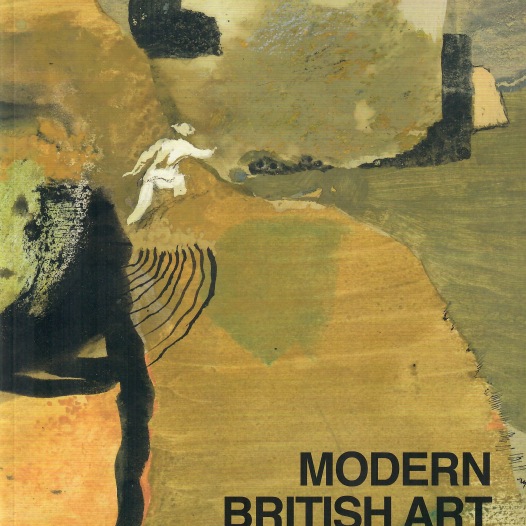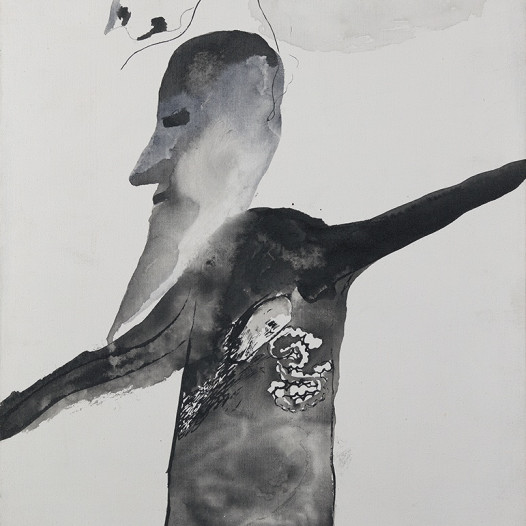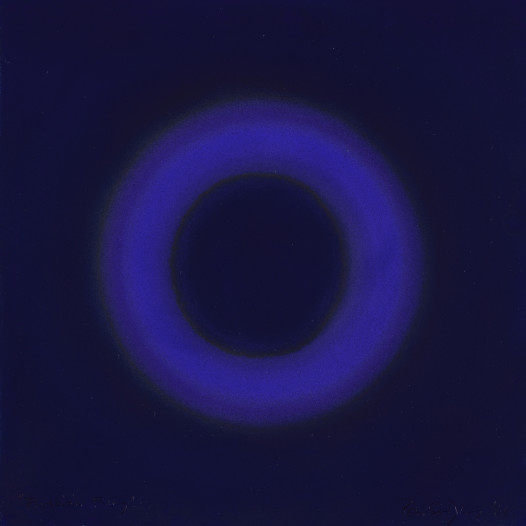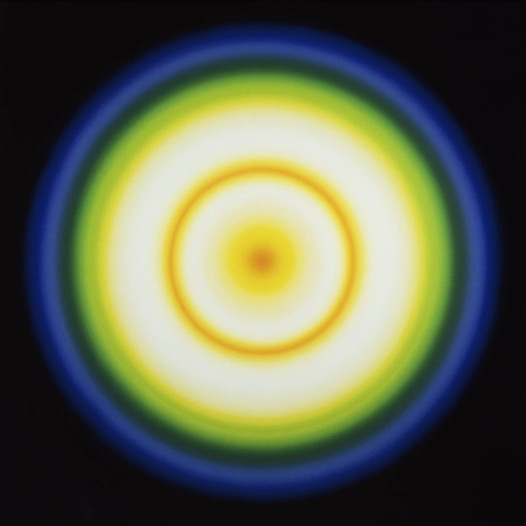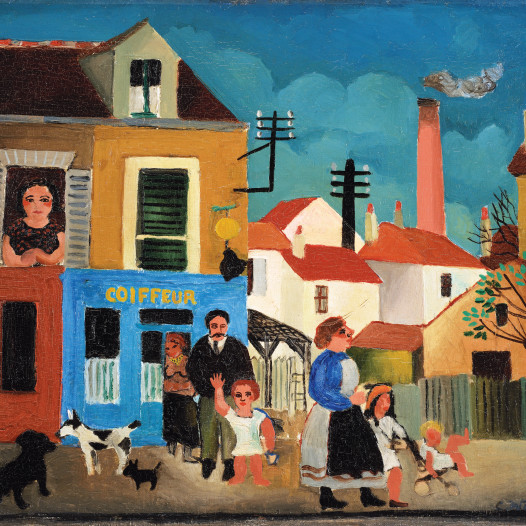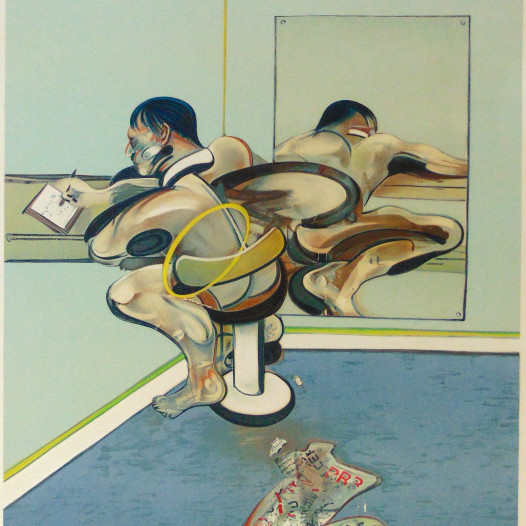Peter Sedgley
b. 1930Peter Sedgley was born in London in 1930, and studied architecture and building work. As a young architect, he was tasked with the rebuilding of post-war Britain, but resigned in protest against what he perceived as attempts to simply recreate, rather than to innovate. He then served as a radar technician in the RAF and was a founding member of a design and construction cooperative, before embarking upon a career as an artist. Self-taught, he developed an early interest in colour theory, and read Goethe and Klee. He found almost instant recognition for his series of large-scale paintings, in which he sought to "establish a tonal range following the chromatic order, so that a pure colour can be equated tonally with a mutated colour". When unveiled in his first solo show at McRoberts and Tunnard, the exhibits were sold to the Tate as well as the Arts Council of Great Britain. A year later, he was included in The Responsive Eye, at the Museum of Modern Art, New York. This seminal survey show was the first to provide a comprehensive overview of such new trends in modern art, and which was soon to become known as Op Art. The paintings of Josef Albers, Frank Stella, Vasarely and his friend Bridget Riley all featured in this large-scale exhibition.
To further his investigations into colour theory and visual perception, Sedgley began a series of Target paintings. These comprised concentric circles, painted in colours against a black background using a soft-edged spray. Circles were chosen as he believed them to be a neutral shape, and so encouraging the audience to see colour, rather than shape. He realised soon after completing these paintings that light could create colour changes and a sense of apparent movement. "I observed that a cold light intensified some colours and modulated others and warm colours did the contrary". He was therefore inspired to introduce lights, which he programmed to a specific, meticulously researched colour sequence, to create a "dialogue between painted colour and illusion". Sedgley has likened the making of these works, and the ordering of the colours, to the "tuning up of a musical instrument". Known as Colour Cycles, examples were sold to the Tate Gallery in 1970, and the Arts Council of Northern Ireland in 1971. The duration of the light sequences range from a few minutes to forthy-five minutes; the sequence for the painting in the Tate's collection lasts for around ten minutes.
In 1971, Sedgley moved to Berlin, where he has remained ever since. In addition to lights, he introduced sounds to his paintings, as part of the Donaueschinger music festival in 1972, and in the following year collaborated with York Höller on Light Ballet for the Bordeaux Festival. In 1974, in Haus-am-Waldsee, he worked with the composer Mario Bertoncini, who had invented a type of wind harp. This was placed in a room and played by a performer, with light changes dictated by the frequencies of the sounds that they made. Though he removed himself from the London art scene, Sedgley was still included in a number of notable museum exhibitions at this time, including the Royal Academy's survey show of British painting from 1952-77, as well as the Tate's Silver Jubilee exhibition, both staged in 1977. He showed sporadically around Europe in the 1980s, including at the Redfern Gallery in 1983, before solo exhibitions were held in New York and Prague in the following decade. In 1997 he made Colorama, which uses solar power to move a mobile of glass and steel, for the Conference Centre in Dubai. Most recently, Sedgley has been part of museum survey shows of Kinetic and Op Art, in Paris, Lisbon and London, including Electronic Superhighway, at the Whitechapel Art Gallery in 2016.
Works
-
 Peter SedgleyBlue and Green Modulation (II), c.2000Acrylic on board100 x 100 cm[Recent second version of the 1964 painting]%3Cdiv%20class%3D%22artist%22%3E%3Cspan%20class%3D%22artist%22%3E%3Cstrong%3EPeter%20Sedgley%3C/strong%3E%3C/span%3E%3C/div%3E%0D%3Cdiv%20class%3D%22title%22%3E%3Cem%3EBlue%20and%20Green%20Modulation%20%28II%29%3C/em%3E%2C%20c.2000%3C/div%3E%0D%3Cdiv%20class%3D%22medium%22%3EAcrylic%20on%20board%3C/div%3E%0D%3Cdiv%20class%3D%22dimensions%22%3E100%20x%20100%20cm%3C/div%3E%0D%3Cdiv%20class%3D%22edition_details%22%3E%5BRecent%20second%20version%20of%20the%201964%20painting%5D%3C/div%3E
Peter SedgleyBlue and Green Modulation (II), c.2000Acrylic on board100 x 100 cm[Recent second version of the 1964 painting]%3Cdiv%20class%3D%22artist%22%3E%3Cspan%20class%3D%22artist%22%3E%3Cstrong%3EPeter%20Sedgley%3C/strong%3E%3C/span%3E%3C/div%3E%0D%3Cdiv%20class%3D%22title%22%3E%3Cem%3EBlue%20and%20Green%20Modulation%20%28II%29%3C/em%3E%2C%20c.2000%3C/div%3E%0D%3Cdiv%20class%3D%22medium%22%3EAcrylic%20on%20board%3C/div%3E%0D%3Cdiv%20class%3D%22dimensions%22%3E100%20x%20100%20cm%3C/div%3E%0D%3Cdiv%20class%3D%22edition_details%22%3E%5BRecent%20second%20version%20of%20the%201964%20painting%5D%3C/div%3E -
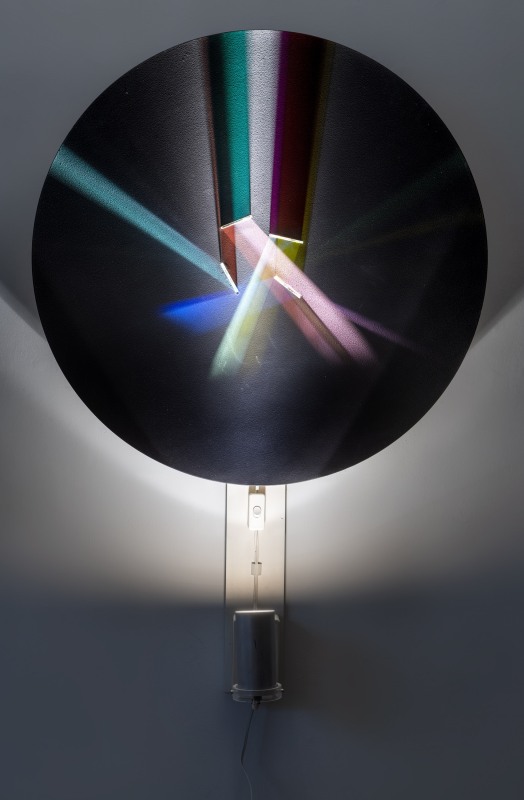 Peter SedgleyBlack Kinetic Light Work, c.1980Mixed media70 cm diameter%3Cdiv%20class%3D%22artist%22%3E%3Cspan%20class%3D%22artist%22%3E%3Cstrong%3EPeter%20Sedgley%3C/strong%3E%3C/span%3E%3C/div%3E%0D%3Cdiv%20class%3D%22title%22%3E%3Cem%3EBlack%20Kinetic%20Light%20Work%3C/em%3E%2C%20c.1980%3C/div%3E%0D%3Cdiv%20class%3D%22medium%22%3EMixed%20media%20%3C/div%3E%0D%3Cdiv%20class%3D%22dimensions%22%3E70%20cm%20diameter%3C/div%3E
Peter SedgleyBlack Kinetic Light Work, c.1980Mixed media70 cm diameter%3Cdiv%20class%3D%22artist%22%3E%3Cspan%20class%3D%22artist%22%3E%3Cstrong%3EPeter%20Sedgley%3C/strong%3E%3C/span%3E%3C/div%3E%0D%3Cdiv%20class%3D%22title%22%3E%3Cem%3EBlack%20Kinetic%20Light%20Work%3C/em%3E%2C%20c.1980%3C/div%3E%0D%3Cdiv%20class%3D%22medium%22%3EMixed%20media%20%3C/div%3E%0D%3Cdiv%20class%3D%22dimensions%22%3E70%20cm%20diameter%3C/div%3E -
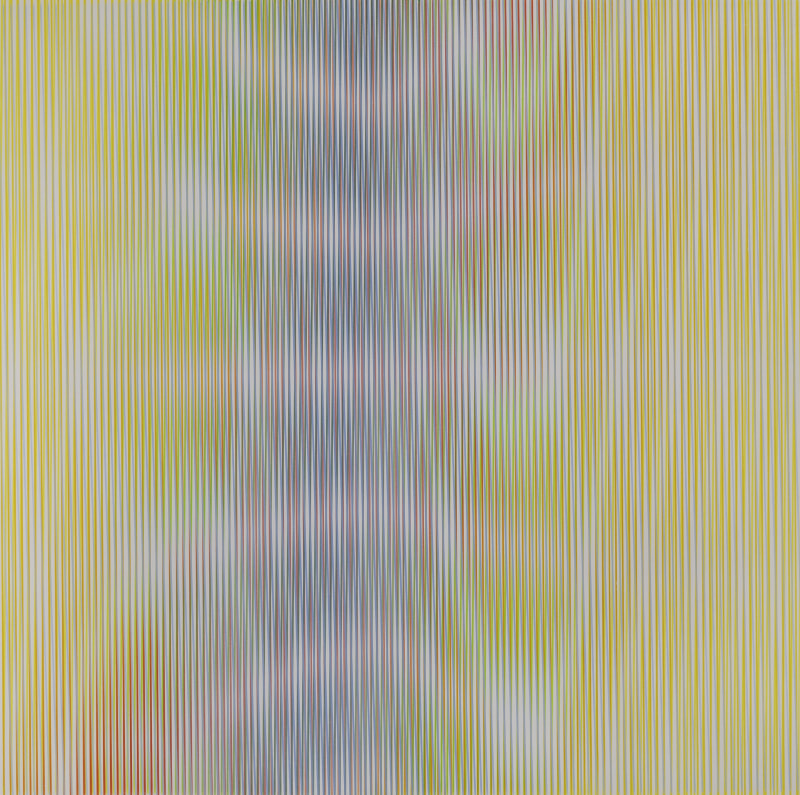 Peter SedgleySpring Fever, c.1980Acrylic on linen120 x 120 cmTitled on edge%3Cdiv%20class%3D%22artist%22%3E%3Cspan%20class%3D%22artist%22%3E%3Cstrong%3EPeter%20Sedgley%3C/strong%3E%3C/span%3E%3C/div%3E%0D%3Cdiv%20class%3D%22title%22%3E%3Cem%3ESpring%20Fever%3C/em%3E%2C%20c.1980%3C/div%3E%0D%3Cdiv%20class%3D%22signed_and_dated%22%3ETitled%20on%20edge%3C/div%3E%0D%3Cdiv%20class%3D%22medium%22%3EAcrylic%20on%20linen%3C/div%3E%0D%3Cdiv%20class%3D%22dimensions%22%3E120%20x%20120%20cm%3C/div%3E
Peter SedgleySpring Fever, c.1980Acrylic on linen120 x 120 cmTitled on edge%3Cdiv%20class%3D%22artist%22%3E%3Cspan%20class%3D%22artist%22%3E%3Cstrong%3EPeter%20Sedgley%3C/strong%3E%3C/span%3E%3C/div%3E%0D%3Cdiv%20class%3D%22title%22%3E%3Cem%3ESpring%20Fever%3C/em%3E%2C%20c.1980%3C/div%3E%0D%3Cdiv%20class%3D%22signed_and_dated%22%3ETitled%20on%20edge%3C/div%3E%0D%3Cdiv%20class%3D%22medium%22%3EAcrylic%20on%20linen%3C/div%3E%0D%3Cdiv%20class%3D%22dimensions%22%3E120%20x%20120%20cm%3C/div%3E -
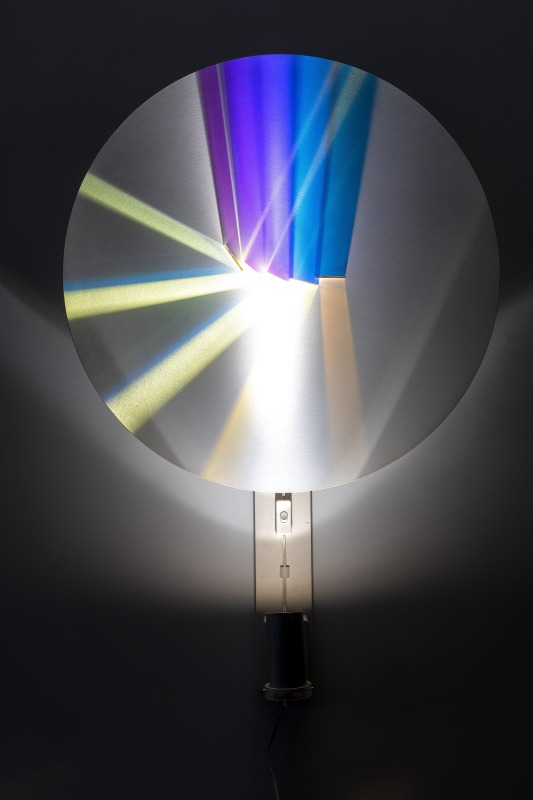 Peter SedgleyWhite Kinetic Light Work , c.1980Mixed media70 cm diameter%3Cdiv%20class%3D%22artist%22%3E%3Cspan%20class%3D%22artist%22%3E%3Cstrong%3EPeter%20Sedgley%3C/strong%3E%3C/span%3E%3C/div%3E%0D%3Cdiv%20class%3D%22title%22%3E%3Cem%3EWhite%20Kinetic%20Light%20Work%20%3C/em%3E%2C%20c.1980%3C/div%3E%0D%3Cdiv%20class%3D%22medium%22%3EMixed%20media%3C/div%3E%0D%3Cdiv%20class%3D%22dimensions%22%3E70%20cm%20diameter%3C/div%3E
Peter SedgleyWhite Kinetic Light Work , c.1980Mixed media70 cm diameter%3Cdiv%20class%3D%22artist%22%3E%3Cspan%20class%3D%22artist%22%3E%3Cstrong%3EPeter%20Sedgley%3C/strong%3E%3C/span%3E%3C/div%3E%0D%3Cdiv%20class%3D%22title%22%3E%3Cem%3EWhite%20Kinetic%20Light%20Work%20%3C/em%3E%2C%20c.1980%3C/div%3E%0D%3Cdiv%20class%3D%22medium%22%3EMixed%20media%3C/div%3E%0D%3Cdiv%20class%3D%22dimensions%22%3E70%20cm%20diameter%3C/div%3E -
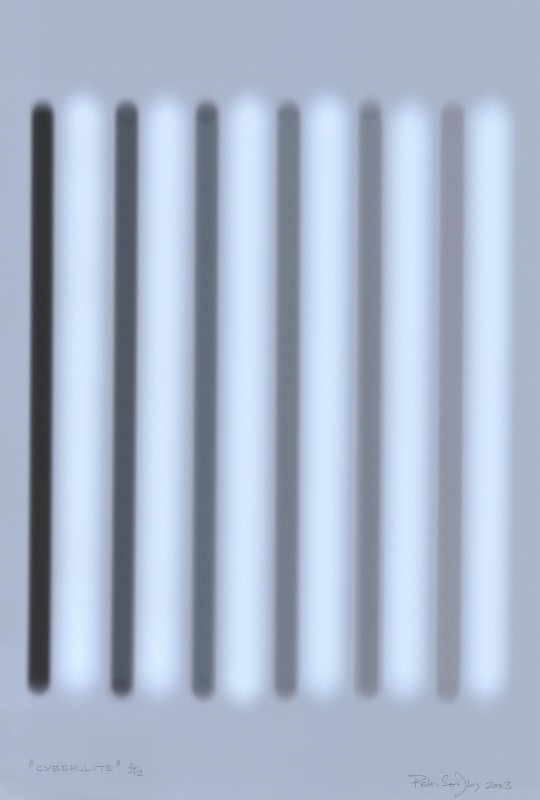 Peter SedgleyCyberlite, 2003Inkjet cybergraph48 x 33 cmFrom the edition of 12 impressionsSigned, dated, titled and numbered%3Cdiv%20class%3D%22artist%22%3E%3Cspan%20class%3D%22artist%22%3E%3Cstrong%3EPeter%20Sedgley%3C/strong%3E%3C/span%3E%3C/div%3E%0D%3Cdiv%20class%3D%22title%22%3E%3Cem%3ECyberlite%3C/em%3E%2C%202003%3C/div%3E%0D%3Cdiv%20class%3D%22signed_and_dated%22%3ESigned%2C%20dated%2C%20titled%20and%20numbered%3C/div%3E%0D%3Cdiv%20class%3D%22medium%22%3EInkjet%20cybergraph%3C/div%3E%0D%3Cdiv%20class%3D%22dimensions%22%3E48%20x%2033%20cm%3C/div%3E%0D%3Cdiv%20class%3D%22edition_details%22%3EFrom%20the%20edition%20of%2012%20impressions%3C/div%3E
Peter SedgleyCyberlite, 2003Inkjet cybergraph48 x 33 cmFrom the edition of 12 impressionsSigned, dated, titled and numbered%3Cdiv%20class%3D%22artist%22%3E%3Cspan%20class%3D%22artist%22%3E%3Cstrong%3EPeter%20Sedgley%3C/strong%3E%3C/span%3E%3C/div%3E%0D%3Cdiv%20class%3D%22title%22%3E%3Cem%3ECyberlite%3C/em%3E%2C%202003%3C/div%3E%0D%3Cdiv%20class%3D%22signed_and_dated%22%3ESigned%2C%20dated%2C%20titled%20and%20numbered%3C/div%3E%0D%3Cdiv%20class%3D%22medium%22%3EInkjet%20cybergraph%3C/div%3E%0D%3Cdiv%20class%3D%22dimensions%22%3E48%20x%2033%20cm%3C/div%3E%0D%3Cdiv%20class%3D%22edition_details%22%3EFrom%20the%20edition%20of%2012%20impressions%3C/div%3E -
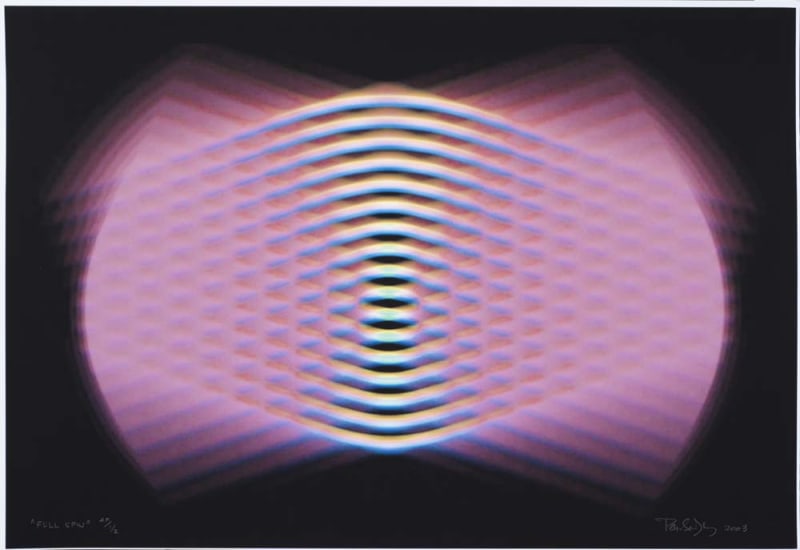 Peter SedgleyFull Spin, 2003Inkjet cybergraph33 x 48 cmFrom the edition of 12 impressionsSigned, dated, titled and numbered%3Cdiv%20class%3D%22artist%22%3E%3Cspan%20class%3D%22artist%22%3E%3Cstrong%3EPeter%20Sedgley%3C/strong%3E%3C/span%3E%3C/div%3E%0D%3Cdiv%20class%3D%22title%22%3E%3Cem%3EFull%20Spin%3C/em%3E%2C%202003%3C/div%3E%0D%3Cdiv%20class%3D%22signed_and_dated%22%3ESigned%2C%20dated%2C%20titled%20and%20numbered%3C/div%3E%0D%3Cdiv%20class%3D%22medium%22%3EInkjet%20cybergraph%3C/div%3E%0D%3Cdiv%20class%3D%22dimensions%22%3E33%20x%2048%20cm%3C/div%3E%0D%3Cdiv%20class%3D%22edition_details%22%3EFrom%20the%20edition%20of%2012%20impressions%3C/div%3E
Peter SedgleyFull Spin, 2003Inkjet cybergraph33 x 48 cmFrom the edition of 12 impressionsSigned, dated, titled and numbered%3Cdiv%20class%3D%22artist%22%3E%3Cspan%20class%3D%22artist%22%3E%3Cstrong%3EPeter%20Sedgley%3C/strong%3E%3C/span%3E%3C/div%3E%0D%3Cdiv%20class%3D%22title%22%3E%3Cem%3EFull%20Spin%3C/em%3E%2C%202003%3C/div%3E%0D%3Cdiv%20class%3D%22signed_and_dated%22%3ESigned%2C%20dated%2C%20titled%20and%20numbered%3C/div%3E%0D%3Cdiv%20class%3D%22medium%22%3EInkjet%20cybergraph%3C/div%3E%0D%3Cdiv%20class%3D%22dimensions%22%3E33%20x%2048%20cm%3C/div%3E%0D%3Cdiv%20class%3D%22edition_details%22%3EFrom%20the%20edition%20of%2012%20impressions%3C/div%3E -
 Peter SedgleySolar Waves, 2003Inkjet cybergraph33 x 49 cmFrom the edition of 12 impressionsSigned, dated, titled and numbered%3Cdiv%20class%3D%22artist%22%3E%3Cspan%20class%3D%22artist%22%3E%3Cstrong%3EPeter%20Sedgley%3C/strong%3E%3C/span%3E%3C/div%3E%0D%3Cdiv%20class%3D%22title%22%3E%3Cem%3ESolar%20Waves%3C/em%3E%2C%202003%3C/div%3E%0D%3Cdiv%20class%3D%22signed_and_dated%22%3ESigned%2C%20dated%2C%20titled%20and%20numbered%3C/div%3E%0D%3Cdiv%20class%3D%22medium%22%3EInkjet%20cybergraph%3C/div%3E%0D%3Cdiv%20class%3D%22dimensions%22%3E33%20x%2049%20cm%3C/div%3E%0D%3Cdiv%20class%3D%22edition_details%22%3EFrom%20the%20edition%20of%2012%20impressions%3C/div%3E
Peter SedgleySolar Waves, 2003Inkjet cybergraph33 x 49 cmFrom the edition of 12 impressionsSigned, dated, titled and numbered%3Cdiv%20class%3D%22artist%22%3E%3Cspan%20class%3D%22artist%22%3E%3Cstrong%3EPeter%20Sedgley%3C/strong%3E%3C/span%3E%3C/div%3E%0D%3Cdiv%20class%3D%22title%22%3E%3Cem%3ESolar%20Waves%3C/em%3E%2C%202003%3C/div%3E%0D%3Cdiv%20class%3D%22signed_and_dated%22%3ESigned%2C%20dated%2C%20titled%20and%20numbered%3C/div%3E%0D%3Cdiv%20class%3D%22medium%22%3EInkjet%20cybergraph%3C/div%3E%0D%3Cdiv%20class%3D%22dimensions%22%3E33%20x%2049%20cm%3C/div%3E%0D%3Cdiv%20class%3D%22edition_details%22%3EFrom%20the%20edition%20of%2012%20impressions%3C/div%3E -
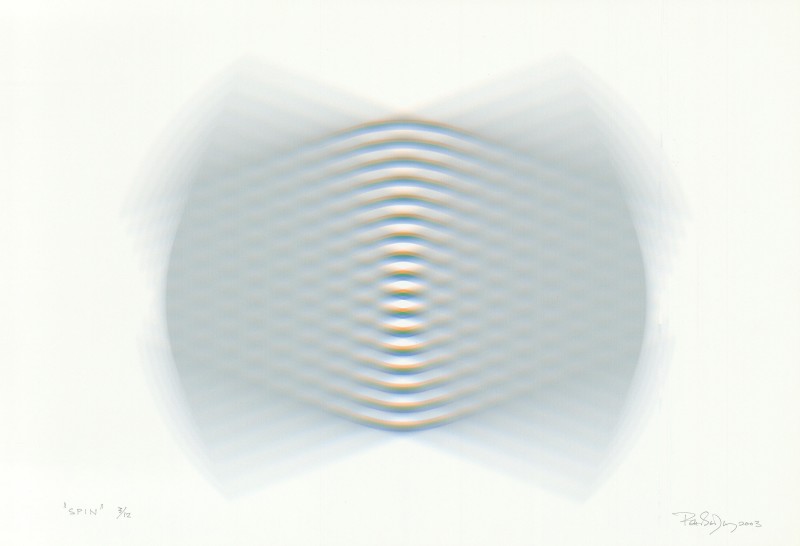 Peter SedgleySpin, 2003Inkjet cybergraph33 x 48.5 cmFrom the edition of 12 impressions%3Cdiv%20class%3D%22artist%22%3E%3Cspan%20class%3D%22artist%22%3E%3Cstrong%3EPeter%20Sedgley%3C/strong%3E%3C/span%3E%3C/div%3E%0D%3Cdiv%20class%3D%22title%22%3E%3Cem%3ESpin%3C/em%3E%2C%202003%3C/div%3E%0D%3Cdiv%20class%3D%22medium%22%3EInkjet%20cybergraph%3C/div%3E%0D%3Cdiv%20class%3D%22dimensions%22%3E33%20x%2048.5%20cm%3C/div%3E%0D%3Cdiv%20class%3D%22edition_details%22%3EFrom%20the%20edition%20of%2012%20impressions%3C/div%3E
Peter SedgleySpin, 2003Inkjet cybergraph33 x 48.5 cmFrom the edition of 12 impressions%3Cdiv%20class%3D%22artist%22%3E%3Cspan%20class%3D%22artist%22%3E%3Cstrong%3EPeter%20Sedgley%3C/strong%3E%3C/span%3E%3C/div%3E%0D%3Cdiv%20class%3D%22title%22%3E%3Cem%3ESpin%3C/em%3E%2C%202003%3C/div%3E%0D%3Cdiv%20class%3D%22medium%22%3EInkjet%20cybergraph%3C/div%3E%0D%3Cdiv%20class%3D%22dimensions%22%3E33%20x%2048.5%20cm%3C/div%3E%0D%3Cdiv%20class%3D%22edition_details%22%3EFrom%20the%20edition%20of%2012%20impressions%3C/div%3E -
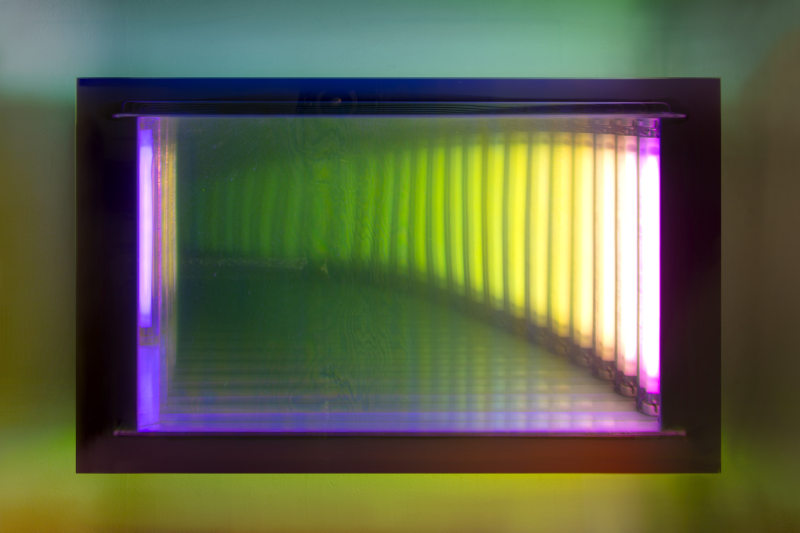 Peter SedgleyWindome - Purple and Green, 2002Dichroic glass light relief36 x 60 x 7.5 cm%3Cdiv%20class%3D%22artist%22%3E%3Cspan%20class%3D%22artist%22%3E%3Cstrong%3EPeter%20Sedgley%3C/strong%3E%3C/span%3E%3C/div%3E%0D%3Cdiv%20class%3D%22title%22%3E%3Cem%3EWindome%20-%20Purple%20and%20Green%3C/em%3E%2C%202002%3C/div%3E%0D%3Cdiv%20class%3D%22medium%22%3EDichroic%20glass%20light%20relief%3C/div%3E%0D%3Cdiv%20class%3D%22dimensions%22%3E36%20x%2060%20x%207.5%20cm%3C/div%3E
Peter SedgleyWindome - Purple and Green, 2002Dichroic glass light relief36 x 60 x 7.5 cm%3Cdiv%20class%3D%22artist%22%3E%3Cspan%20class%3D%22artist%22%3E%3Cstrong%3EPeter%20Sedgley%3C/strong%3E%3C/span%3E%3C/div%3E%0D%3Cdiv%20class%3D%22title%22%3E%3Cem%3EWindome%20-%20Purple%20and%20Green%3C/em%3E%2C%202002%3C/div%3E%0D%3Cdiv%20class%3D%22medium%22%3EDichroic%20glass%20light%20relief%3C/div%3E%0D%3Cdiv%20class%3D%22dimensions%22%3E36%20x%2060%20x%207.5%20cm%3C/div%3E -
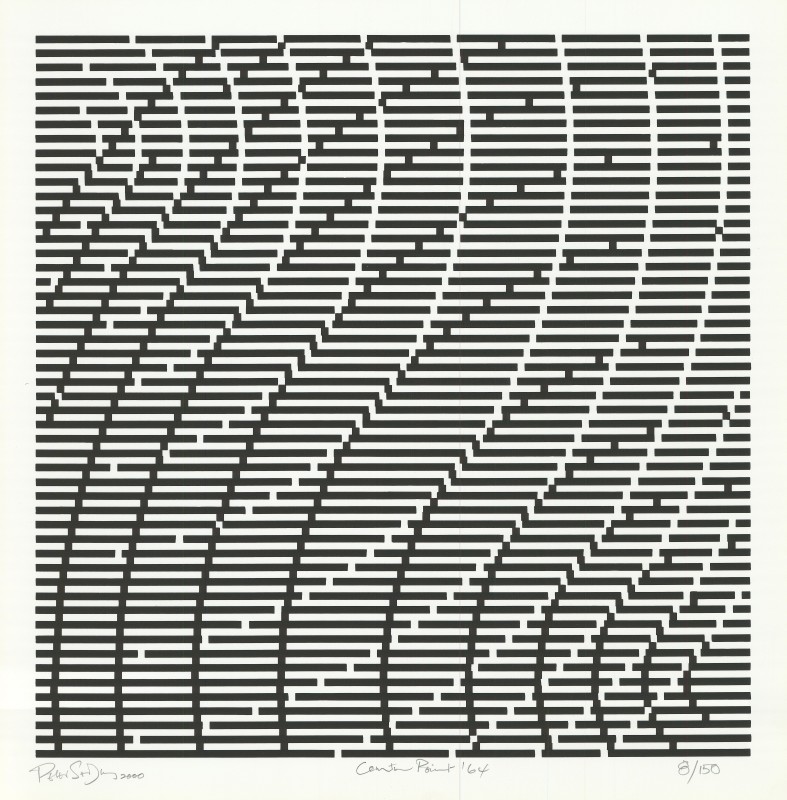 Peter SedgleyCounterpoint '64, 2000Screenprint68 x 67 cmFrom the edition of 150 impressionsSigned, dated, titled and numbered%3Cdiv%20class%3D%22artist%22%3E%3Cspan%20class%3D%22artist%22%3E%3Cstrong%3EPeter%20Sedgley%3C/strong%3E%3C/span%3E%3C/div%3E%0D%3Cdiv%20class%3D%22title%22%3E%3Cem%3ECounterpoint%20%2764%3C/em%3E%2C%202000%3C/div%3E%0D%3Cdiv%20class%3D%22signed_and_dated%22%3ESigned%2C%20dated%2C%20titled%20and%20numbered%3C/div%3E%0D%3Cdiv%20class%3D%22medium%22%3EScreenprint%3C/div%3E%0D%3Cdiv%20class%3D%22dimensions%22%3E68%20x%2067%20cm%3C/div%3E%0D%3Cdiv%20class%3D%22edition_details%22%3EFrom%20the%20edition%20of%20150%20impressions%3C/div%3E
Peter SedgleyCounterpoint '64, 2000Screenprint68 x 67 cmFrom the edition of 150 impressionsSigned, dated, titled and numbered%3Cdiv%20class%3D%22artist%22%3E%3Cspan%20class%3D%22artist%22%3E%3Cstrong%3EPeter%20Sedgley%3C/strong%3E%3C/span%3E%3C/div%3E%0D%3Cdiv%20class%3D%22title%22%3E%3Cem%3ECounterpoint%20%2764%3C/em%3E%2C%202000%3C/div%3E%0D%3Cdiv%20class%3D%22signed_and_dated%22%3ESigned%2C%20dated%2C%20titled%20and%20numbered%3C/div%3E%0D%3Cdiv%20class%3D%22medium%22%3EScreenprint%3C/div%3E%0D%3Cdiv%20class%3D%22dimensions%22%3E68%20x%2067%20cm%3C/div%3E%0D%3Cdiv%20class%3D%22edition_details%22%3EFrom%20the%20edition%20of%20150%20impressions%3C/div%3E -
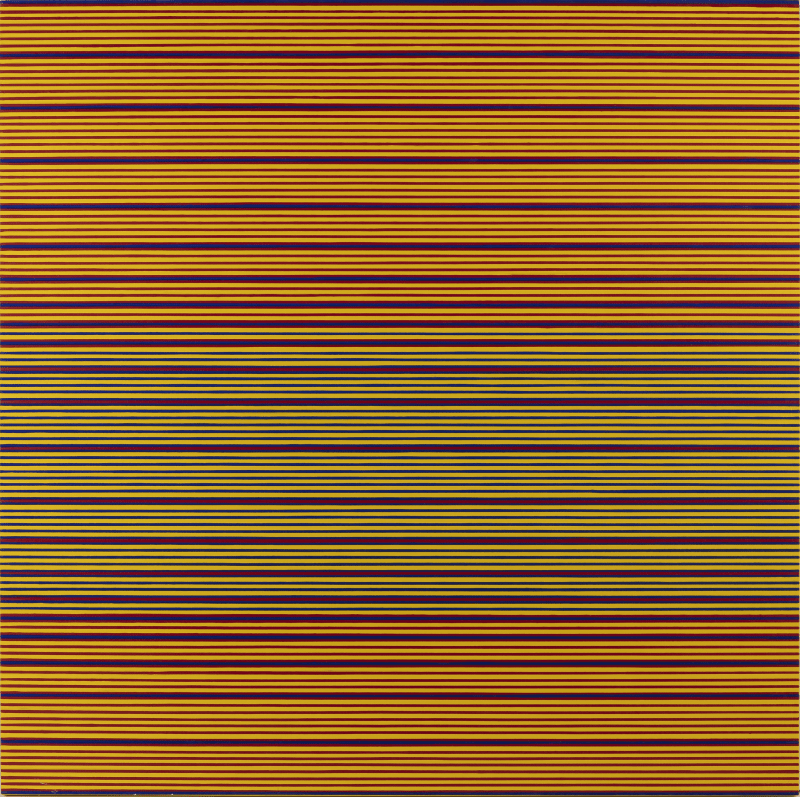 Peter SedgleyYellow Attenuation II , 2000Acrylic on board100 x 100 cm[Another version of Yellow Attenuation 1965 in Tate's collection]%3Cdiv%20class%3D%22artist%22%3E%3Cspan%20class%3D%22artist%22%3E%3Cstrong%3EPeter%20Sedgley%3C/strong%3E%3C/span%3E%3C/div%3E%0D%3Cdiv%20class%3D%22title%22%3E%3Cem%3EYellow%20Attenuation%20II%20%3C/em%3E%2C%202000%3C/div%3E%0D%3Cdiv%20class%3D%22medium%22%3EAcrylic%20on%20board%3C/div%3E%0D%3Cdiv%20class%3D%22dimensions%22%3E100%20x%20100%20cm%3C/div%3E%0D%3Cdiv%20class%3D%22edition_details%22%3E%5BAnother%20version%20of%20Yellow%20Attenuation%201965%20in%20Tate%27s%20collection%5D%3C/div%3E
Peter SedgleyYellow Attenuation II , 2000Acrylic on board100 x 100 cm[Another version of Yellow Attenuation 1965 in Tate's collection]%3Cdiv%20class%3D%22artist%22%3E%3Cspan%20class%3D%22artist%22%3E%3Cstrong%3EPeter%20Sedgley%3C/strong%3E%3C/span%3E%3C/div%3E%0D%3Cdiv%20class%3D%22title%22%3E%3Cem%3EYellow%20Attenuation%20II%20%3C/em%3E%2C%202000%3C/div%3E%0D%3Cdiv%20class%3D%22medium%22%3EAcrylic%20on%20board%3C/div%3E%0D%3Cdiv%20class%3D%22dimensions%22%3E100%20x%20100%20cm%3C/div%3E%0D%3Cdiv%20class%3D%22edition_details%22%3E%5BAnother%20version%20of%20Yellow%20Attenuation%201965%20in%20Tate%27s%20collection%5D%3C/div%3E -
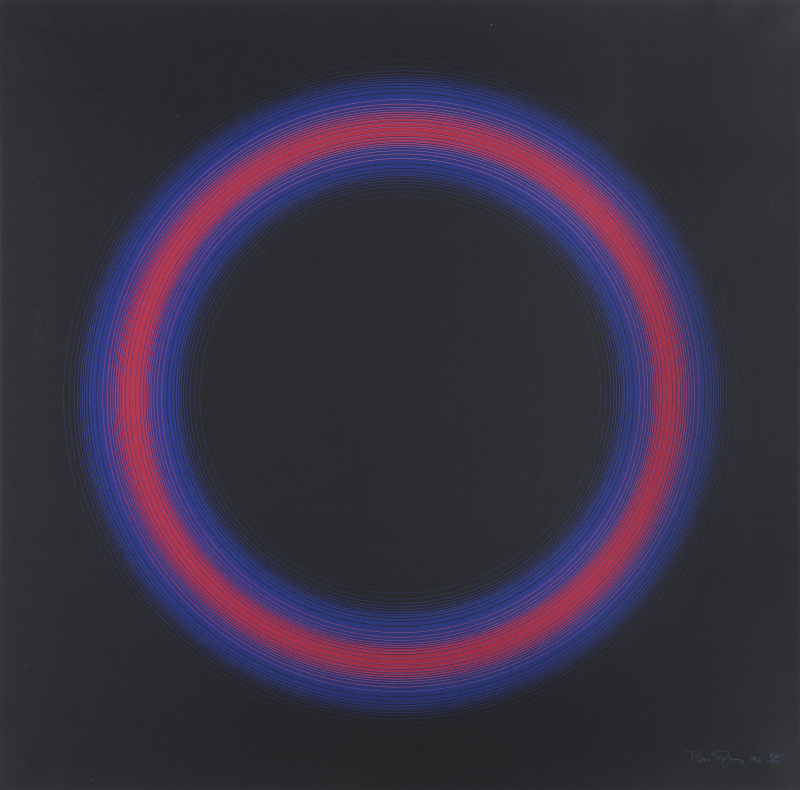 Peter SedgleyQuartet Suite - Red/Purple on Black, 1986Screenprint60 x 60 cmEdition of 100 impressions%3Cdiv%20class%3D%22artist%22%3E%3Cspan%20class%3D%22artist%22%3E%3Cstrong%3EPeter%20Sedgley%3C/strong%3E%3C/span%3E%3C/div%3E%0D%3Cdiv%20class%3D%22title%22%3E%3Cem%3EQuartet%20Suite%20-%20Red/Purple%20on%20Black%3C/em%3E%2C%201986%3C/div%3E%0D%3Cdiv%20class%3D%22medium%22%3EScreenprint%20%3C/div%3E%0D%3Cdiv%20class%3D%22dimensions%22%3E60%20x%2060%20cm%3C/div%3E%0D%3Cdiv%20class%3D%22edition_details%22%3EEdition%20of%20100%20impressions%3C/div%3E
Peter SedgleyQuartet Suite - Red/Purple on Black, 1986Screenprint60 x 60 cmEdition of 100 impressions%3Cdiv%20class%3D%22artist%22%3E%3Cspan%20class%3D%22artist%22%3E%3Cstrong%3EPeter%20Sedgley%3C/strong%3E%3C/span%3E%3C/div%3E%0D%3Cdiv%20class%3D%22title%22%3E%3Cem%3EQuartet%20Suite%20-%20Red/Purple%20on%20Black%3C/em%3E%2C%201986%3C/div%3E%0D%3Cdiv%20class%3D%22medium%22%3EScreenprint%20%3C/div%3E%0D%3Cdiv%20class%3D%22dimensions%22%3E60%20x%2060%20cm%3C/div%3E%0D%3Cdiv%20class%3D%22edition_details%22%3EEdition%20of%20100%20impressions%3C/div%3E -
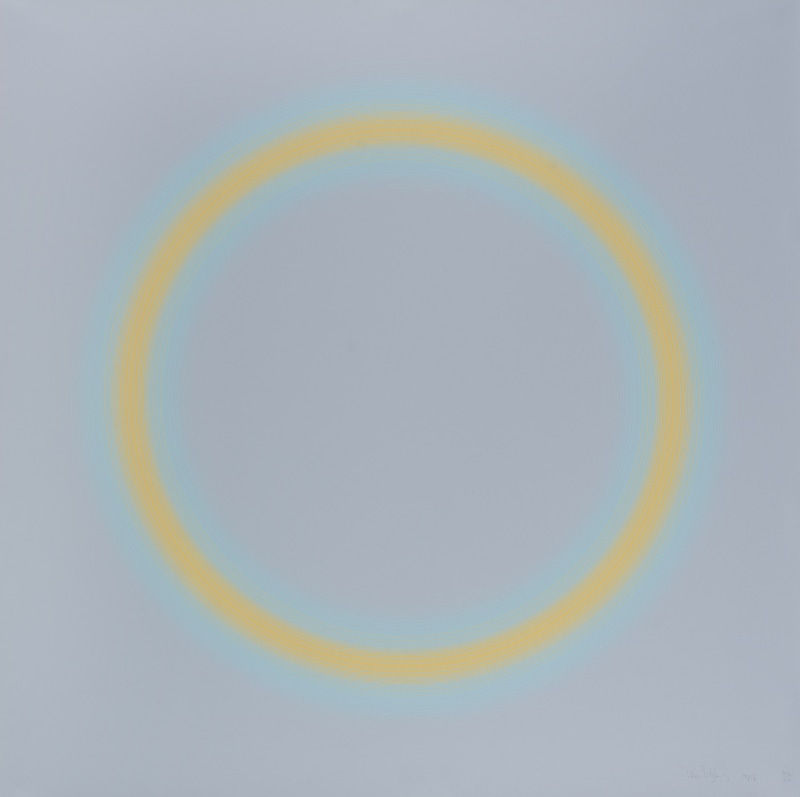 Peter SedgleyQuartet Suite - Yellow/Blue on Light Blue, 1986Screenprint60 x 60 cmEdition of 100 impressions%3Cdiv%20class%3D%22artist%22%3E%3Cspan%20class%3D%22artist%22%3E%3Cstrong%3EPeter%20Sedgley%20%3C/strong%3E%3C/span%3E%3C/div%3E%0D%3Cdiv%20class%3D%22title%22%3E%3Cem%3EQuartet%20Suite%20-%20Yellow/Blue%20on%20Light%20Blue%3C/em%3E%2C%201986%3C/div%3E%0D%3Cdiv%20class%3D%22medium%22%3EScreenprint%20%3C/div%3E%0D%3Cdiv%20class%3D%22dimensions%22%3E60%20x%2060%20cm%3C/div%3E%0D%3Cdiv%20class%3D%22edition_details%22%3EEdition%20of%20100%20impressions%20%3C/div%3E
Peter SedgleyQuartet Suite - Yellow/Blue on Light Blue, 1986Screenprint60 x 60 cmEdition of 100 impressions%3Cdiv%20class%3D%22artist%22%3E%3Cspan%20class%3D%22artist%22%3E%3Cstrong%3EPeter%20Sedgley%20%3C/strong%3E%3C/span%3E%3C/div%3E%0D%3Cdiv%20class%3D%22title%22%3E%3Cem%3EQuartet%20Suite%20-%20Yellow/Blue%20on%20Light%20Blue%3C/em%3E%2C%201986%3C/div%3E%0D%3Cdiv%20class%3D%22medium%22%3EScreenprint%20%3C/div%3E%0D%3Cdiv%20class%3D%22dimensions%22%3E60%20x%2060%20cm%3C/div%3E%0D%3Cdiv%20class%3D%22edition_details%22%3EEdition%20of%20100%20impressions%20%3C/div%3E -
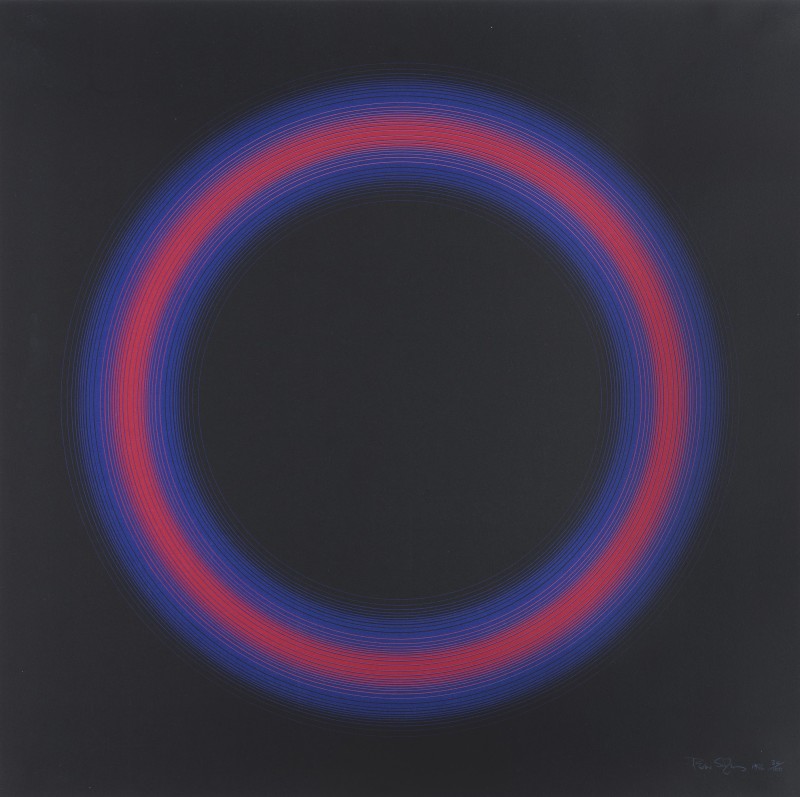 Peter SedgleyQuartet Suite: Red/Purple on Black, 1986Screenprint60 x 60 cmFrom the edition of 100 impressionsSigned, dated and numbered%3Cdiv%20class%3D%22artist%22%3E%3Cspan%20class%3D%22artist%22%3E%3Cstrong%3EPeter%20Sedgley%3C/strong%3E%3C/span%3E%3C/div%3E%0D%3Cdiv%20class%3D%22title%22%3E%3Cem%3EQuartet%20Suite%3A%20Red/Purple%20on%20Black%3C/em%3E%2C%201986%3C/div%3E%0D%3Cdiv%20class%3D%22signed_and_dated%22%3ESigned%2C%20dated%20and%20numbered%3C/div%3E%0D%3Cdiv%20class%3D%22medium%22%3EScreenprint%3C/div%3E%0D%3Cdiv%20class%3D%22dimensions%22%3E60%20x%2060%20cm%3C/div%3E%0D%3Cdiv%20class%3D%22edition_details%22%3EFrom%20the%20edition%20of%20100%20impressions%3C/div%3E
Peter SedgleyQuartet Suite: Red/Purple on Black, 1986Screenprint60 x 60 cmFrom the edition of 100 impressionsSigned, dated and numbered%3Cdiv%20class%3D%22artist%22%3E%3Cspan%20class%3D%22artist%22%3E%3Cstrong%3EPeter%20Sedgley%3C/strong%3E%3C/span%3E%3C/div%3E%0D%3Cdiv%20class%3D%22title%22%3E%3Cem%3EQuartet%20Suite%3A%20Red/Purple%20on%20Black%3C/em%3E%2C%201986%3C/div%3E%0D%3Cdiv%20class%3D%22signed_and_dated%22%3ESigned%2C%20dated%20and%20numbered%3C/div%3E%0D%3Cdiv%20class%3D%22medium%22%3EScreenprint%3C/div%3E%0D%3Cdiv%20class%3D%22dimensions%22%3E60%20x%2060%20cm%3C/div%3E%0D%3Cdiv%20class%3D%22edition_details%22%3EFrom%20the%20edition%20of%20100%20impressions%3C/div%3E -
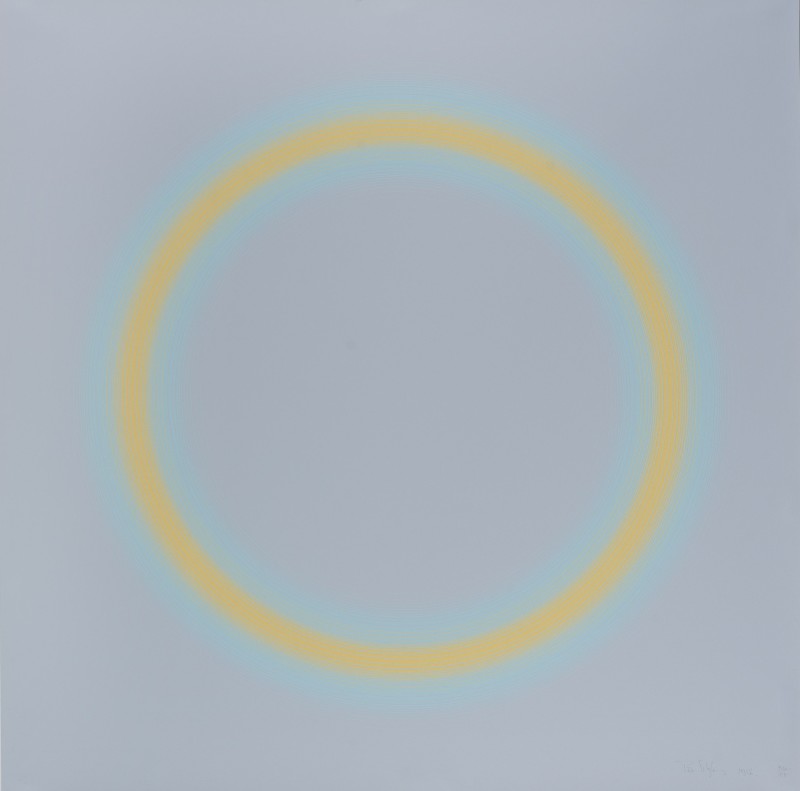 Peter SedgleyQuartet Suite: Yellow/Blue on Light Blue, 1986Screenprint60 x 60 cmFrom the edition of 100 impressionsSigned, dated and numbered%3Cdiv%20class%3D%22artist%22%3E%3Cspan%20class%3D%22artist%22%3E%3Cstrong%3EPeter%20Sedgley%3C/strong%3E%3C/span%3E%3C/div%3E%0D%3Cdiv%20class%3D%22title%22%3E%3Cem%3EQuartet%20Suite%3A%20Yellow/Blue%20on%20Light%20Blue%3C/em%3E%2C%201986%3C/div%3E%0D%3Cdiv%20class%3D%22signed_and_dated%22%3ESigned%2C%20dated%20and%20numbered%3C/div%3E%0D%3Cdiv%20class%3D%22medium%22%3EScreenprint%3C/div%3E%0D%3Cdiv%20class%3D%22dimensions%22%3E60%20x%2060%20cm%3C/div%3E%0D%3Cdiv%20class%3D%22edition_details%22%3EFrom%20the%20edition%20of%20100%20impressions%3C/div%3E
Peter SedgleyQuartet Suite: Yellow/Blue on Light Blue, 1986Screenprint60 x 60 cmFrom the edition of 100 impressionsSigned, dated and numbered%3Cdiv%20class%3D%22artist%22%3E%3Cspan%20class%3D%22artist%22%3E%3Cstrong%3EPeter%20Sedgley%3C/strong%3E%3C/span%3E%3C/div%3E%0D%3Cdiv%20class%3D%22title%22%3E%3Cem%3EQuartet%20Suite%3A%20Yellow/Blue%20on%20Light%20Blue%3C/em%3E%2C%201986%3C/div%3E%0D%3Cdiv%20class%3D%22signed_and_dated%22%3ESigned%2C%20dated%20and%20numbered%3C/div%3E%0D%3Cdiv%20class%3D%22medium%22%3EScreenprint%3C/div%3E%0D%3Cdiv%20class%3D%22dimensions%22%3E60%20x%2060%20cm%3C/div%3E%0D%3Cdiv%20class%3D%22edition_details%22%3EFrom%20the%20edition%20of%20100%20impressions%3C/div%3E -
 Peter SedgleyDisc No 2, 1983Gouache on card56.5 x 56.5 cm%3Cdiv%20class%3D%22artist%22%3E%3Cspan%20class%3D%22artist%22%3E%3Cstrong%3EPeter%20Sedgley%3C/strong%3E%3C/span%3E%3C/div%3E%0D%3Cdiv%20class%3D%22title%22%3E%3Cem%3EDisc%20No%202%3C/em%3E%2C%201983%3C/div%3E%0D%3Cdiv%20class%3D%22medium%22%3EGouache%20on%20card%3C/div%3E%0D%3Cdiv%20class%3D%22dimensions%22%3E56.5%20x%2056.5%20cm%3C/div%3E
Peter SedgleyDisc No 2, 1983Gouache on card56.5 x 56.5 cm%3Cdiv%20class%3D%22artist%22%3E%3Cspan%20class%3D%22artist%22%3E%3Cstrong%3EPeter%20Sedgley%3C/strong%3E%3C/span%3E%3C/div%3E%0D%3Cdiv%20class%3D%22title%22%3E%3Cem%3EDisc%20No%202%3C/em%3E%2C%201983%3C/div%3E%0D%3Cdiv%20class%3D%22medium%22%3EGouache%20on%20card%3C/div%3E%0D%3Cdiv%20class%3D%22dimensions%22%3E56.5%20x%2056.5%20cm%3C/div%3E -
 Peter SedgleyRipple , 1983Gouache on paper67.6 x 48 cm%3Cdiv%20class%3D%22artist%22%3E%3Cspan%20class%3D%22artist%22%3E%3Cstrong%3EPeter%20Sedgley%3C/strong%3E%3C/span%3E%3C/div%3E%0D%3Cdiv%20class%3D%22title%22%3E%3Cem%3ERipple%20%3C/em%3E%2C%201983%3C/div%3E%0D%3Cdiv%20class%3D%22medium%22%3EGouache%20on%20paper%3C/div%3E%0D%3Cdiv%20class%3D%22dimensions%22%3E67.6%20x%2048%20cm%20%3C/div%3E
Peter SedgleyRipple , 1983Gouache on paper67.6 x 48 cm%3Cdiv%20class%3D%22artist%22%3E%3Cspan%20class%3D%22artist%22%3E%3Cstrong%3EPeter%20Sedgley%3C/strong%3E%3C/span%3E%3C/div%3E%0D%3Cdiv%20class%3D%22title%22%3E%3Cem%3ERipple%20%3C/em%3E%2C%201983%3C/div%3E%0D%3Cdiv%20class%3D%22medium%22%3EGouache%20on%20paper%3C/div%3E%0D%3Cdiv%20class%3D%22dimensions%22%3E67.6%20x%2048%20cm%20%3C/div%3E -
 Peter SedgleyBlack and Orange, 1982Acrylic on paper71 x 102 cm%3Cdiv%20class%3D%22artist%22%3E%3Cspan%20class%3D%22artist%22%3E%3Cstrong%3EPeter%20Sedgley%3C/strong%3E%3C/span%3E%3C/div%3E%0D%3Cdiv%20class%3D%22title%22%3E%3Cem%3EBlack%20and%20Orange%3C/em%3E%2C%201982%3C/div%3E%0D%3Cdiv%20class%3D%22medium%22%3EAcrylic%20on%20paper%3C/div%3E%0D%3Cdiv%20class%3D%22dimensions%22%3E71%20x%20102%20cm%3C/div%3E
Peter SedgleyBlack and Orange, 1982Acrylic on paper71 x 102 cm%3Cdiv%20class%3D%22artist%22%3E%3Cspan%20class%3D%22artist%22%3E%3Cstrong%3EPeter%20Sedgley%3C/strong%3E%3C/span%3E%3C/div%3E%0D%3Cdiv%20class%3D%22title%22%3E%3Cem%3EBlack%20and%20Orange%3C/em%3E%2C%201982%3C/div%3E%0D%3Cdiv%20class%3D%22medium%22%3EAcrylic%20on%20paper%3C/div%3E%0D%3Cdiv%20class%3D%22dimensions%22%3E71%20x%20102%20cm%3C/div%3E -
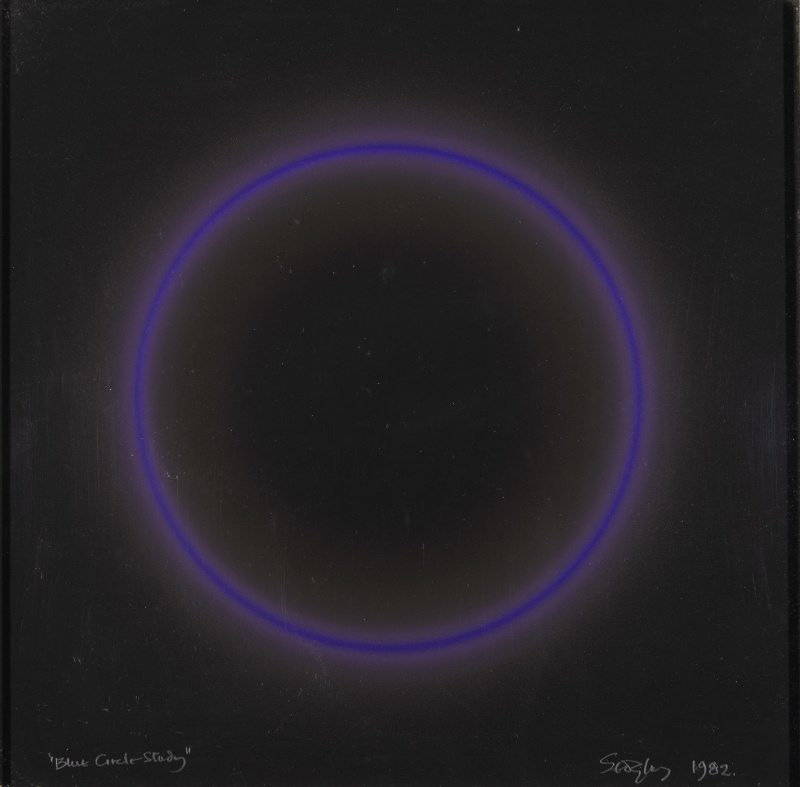 Peter SedgleyBlue Circle Study, 1982Gouache on paper33 x 33 cmSigned, dated and titled%3Cdiv%20class%3D%22artist%22%3E%3Cspan%20class%3D%22artist%22%3E%3Cstrong%3EPeter%20Sedgley%3C/strong%3E%3C/span%3E%3C/div%3E%0D%3Cdiv%20class%3D%22title%22%3E%3Cem%3EBlue%20Circle%20Study%3C/em%3E%2C%201982%3C/div%3E%0D%3Cdiv%20class%3D%22signed_and_dated%22%3ESigned%2C%20dated%20and%20titled%3C/div%3E%0D%3Cdiv%20class%3D%22medium%22%3EGouache%20on%20paper%3C/div%3E%0D%3Cdiv%20class%3D%22dimensions%22%3E33%20x%2033%20cm%3C/div%3E
Peter SedgleyBlue Circle Study, 1982Gouache on paper33 x 33 cmSigned, dated and titled%3Cdiv%20class%3D%22artist%22%3E%3Cspan%20class%3D%22artist%22%3E%3Cstrong%3EPeter%20Sedgley%3C/strong%3E%3C/span%3E%3C/div%3E%0D%3Cdiv%20class%3D%22title%22%3E%3Cem%3EBlue%20Circle%20Study%3C/em%3E%2C%201982%3C/div%3E%0D%3Cdiv%20class%3D%22signed_and_dated%22%3ESigned%2C%20dated%20and%20titled%3C/div%3E%0D%3Cdiv%20class%3D%22medium%22%3EGouache%20on%20paper%3C/div%3E%0D%3Cdiv%20class%3D%22dimensions%22%3E33%20x%2033%20cm%3C/div%3E -
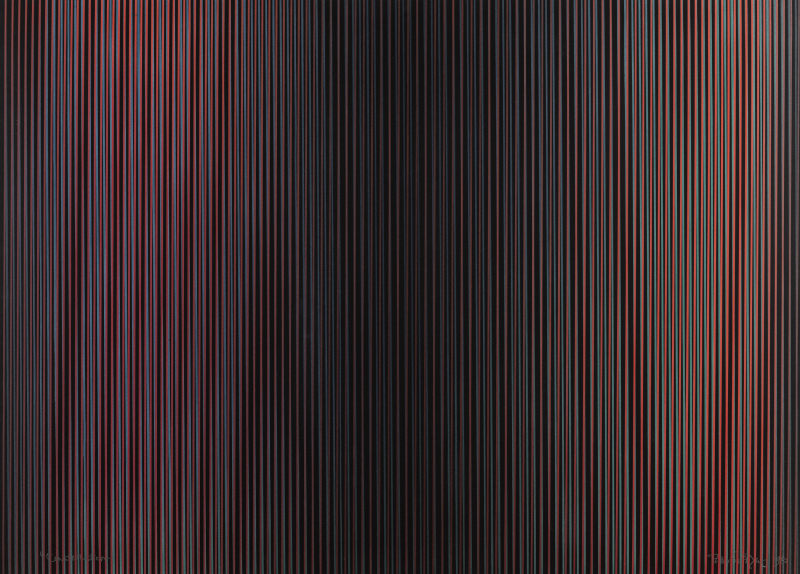 Peter SedgleyConstellation , 1982Acrylic on card67 x 93 cm%3Cdiv%20class%3D%22artist%22%3E%3Cspan%20class%3D%22artist%22%3E%3Cstrong%3EPeter%20Sedgley%3C/strong%3E%3C/span%3E%3C/div%3E%0D%3Cdiv%20class%3D%22title%22%3E%3Cem%3EConstellation%20%3C/em%3E%2C%201982%3C/div%3E%0D%3Cdiv%20class%3D%22medium%22%3EAcrylic%20on%20card%3C/div%3E%0D%3Cdiv%20class%3D%22dimensions%22%3E67%20x%2093%20cm%3C/div%3E
Peter SedgleyConstellation , 1982Acrylic on card67 x 93 cm%3Cdiv%20class%3D%22artist%22%3E%3Cspan%20class%3D%22artist%22%3E%3Cstrong%3EPeter%20Sedgley%3C/strong%3E%3C/span%3E%3C/div%3E%0D%3Cdiv%20class%3D%22title%22%3E%3Cem%3EConstellation%20%3C/em%3E%2C%201982%3C/div%3E%0D%3Cdiv%20class%3D%22medium%22%3EAcrylic%20on%20card%3C/div%3E%0D%3Cdiv%20class%3D%22dimensions%22%3E67%20x%2093%20cm%3C/div%3E -
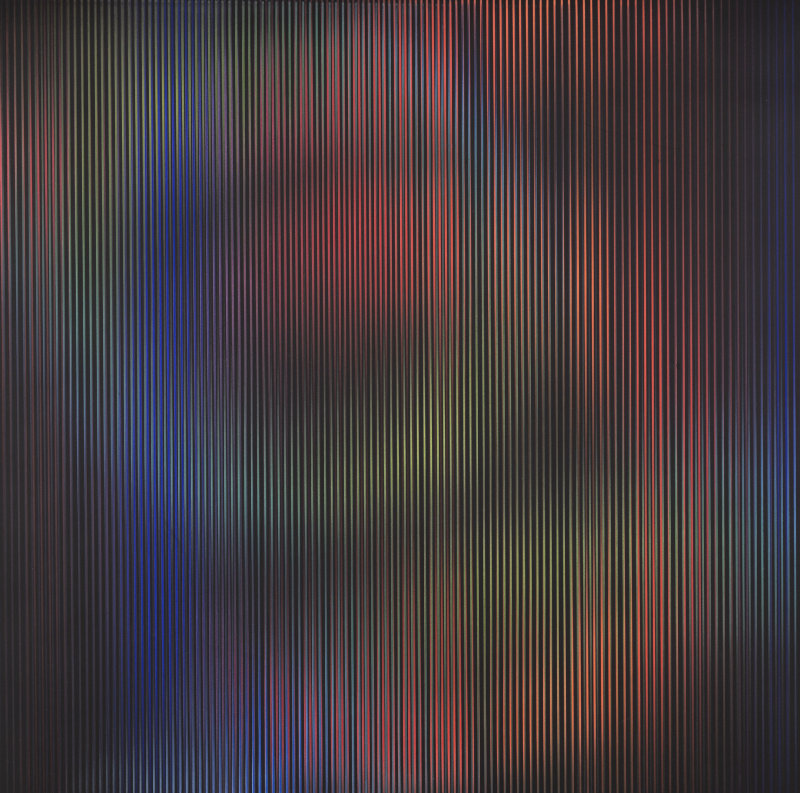 Peter SedgleyCryptic, 1982Acrylic on linen120 x 120 cmSigned, dated and titled on reverse%3Cdiv%20class%3D%22artist%22%3E%3Cspan%20class%3D%22artist%22%3E%3Cstrong%3EPeter%20Sedgley%3C/strong%3E%3C/span%3E%3C/div%3E%0D%3Cdiv%20class%3D%22title%22%3E%3Cem%3ECryptic%3C/em%3E%2C%201982%3C/div%3E%0D%3Cdiv%20class%3D%22signed_and_dated%22%3ESigned%2C%20dated%20and%20titled%20on%20reverse%3C/div%3E%0D%3Cdiv%20class%3D%22medium%22%3EAcrylic%20on%20linen%3C/div%3E%0D%3Cdiv%20class%3D%22dimensions%22%3E120%20x%20120%20cm%3C/div%3E
Peter SedgleyCryptic, 1982Acrylic on linen120 x 120 cmSigned, dated and titled on reverse%3Cdiv%20class%3D%22artist%22%3E%3Cspan%20class%3D%22artist%22%3E%3Cstrong%3EPeter%20Sedgley%3C/strong%3E%3C/span%3E%3C/div%3E%0D%3Cdiv%20class%3D%22title%22%3E%3Cem%3ECryptic%3C/em%3E%2C%201982%3C/div%3E%0D%3Cdiv%20class%3D%22signed_and_dated%22%3ESigned%2C%20dated%20and%20titled%20on%20reverse%3C/div%3E%0D%3Cdiv%20class%3D%22medium%22%3EAcrylic%20on%20linen%3C/div%3E%0D%3Cdiv%20class%3D%22dimensions%22%3E120%20x%20120%20cm%3C/div%3E -
 Peter SedgleyEye Sign, 1982Marker pen and ink on paper88.8 x 62 cm%3Cdiv%20class%3D%22artist%22%3E%3Cspan%20class%3D%22artist%22%3E%3Cstrong%3EPeter%20Sedgley%3C/strong%3E%3C/span%3E%3C/div%3E%0D%3Cdiv%20class%3D%22title%22%3E%3Cem%3EEye%20Sign%3C/em%3E%2C%201982%3C/div%3E%0D%3Cdiv%20class%3D%22medium%22%3EMarker%20pen%20and%20ink%20on%20paper%3C/div%3E%0D%3Cdiv%20class%3D%22dimensions%22%3E88.8%20x%2062%20cm%3C/div%3E
Peter SedgleyEye Sign, 1982Marker pen and ink on paper88.8 x 62 cm%3Cdiv%20class%3D%22artist%22%3E%3Cspan%20class%3D%22artist%22%3E%3Cstrong%3EPeter%20Sedgley%3C/strong%3E%3C/span%3E%3C/div%3E%0D%3Cdiv%20class%3D%22title%22%3E%3Cem%3EEye%20Sign%3C/em%3E%2C%201982%3C/div%3E%0D%3Cdiv%20class%3D%22medium%22%3EMarker%20pen%20and%20ink%20on%20paper%3C/div%3E%0D%3Cdiv%20class%3D%22dimensions%22%3E88.8%20x%2062%20cm%3C/div%3E -
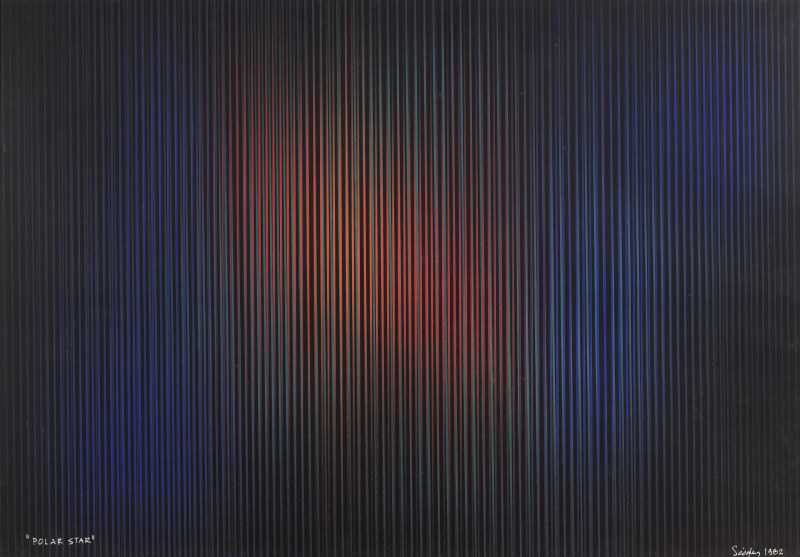 Peter SedgleyPolar Star, 1982Acrylic on card65 x 93 cm%3Cdiv%20class%3D%22artist%22%3E%3Cspan%20class%3D%22artist%22%3E%3Cstrong%3EPeter%20Sedgley%3C/strong%3E%3C/span%3E%3C/div%3E%0D%3Cdiv%20class%3D%22title%22%3E%3Cem%3EPolar%20Star%3C/em%3E%2C%201982%3C/div%3E%0D%3Cdiv%20class%3D%22medium%22%3EAcrylic%20on%20card%3C/div%3E%0D%3Cdiv%20class%3D%22dimensions%22%3E65%20x%2093%20cm%3C/div%3E
Peter SedgleyPolar Star, 1982Acrylic on card65 x 93 cm%3Cdiv%20class%3D%22artist%22%3E%3Cspan%20class%3D%22artist%22%3E%3Cstrong%3EPeter%20Sedgley%3C/strong%3E%3C/span%3E%3C/div%3E%0D%3Cdiv%20class%3D%22title%22%3E%3Cem%3EPolar%20Star%3C/em%3E%2C%201982%3C/div%3E%0D%3Cdiv%20class%3D%22medium%22%3EAcrylic%20on%20card%3C/div%3E%0D%3Cdiv%20class%3D%22dimensions%22%3E65%20x%2093%20cm%3C/div%3E -
 Peter SedgleyRadials In, 1982Acrylic on card24 x 24 cmSigned, dated and titled verso%3Cdiv%20class%3D%22artist%22%3E%3Cspan%20class%3D%22artist%22%3E%3Cstrong%3EPeter%20Sedgley%3C/strong%3E%3C/span%3E%3C/div%3E%0D%3Cdiv%20class%3D%22title%22%3E%3Cem%3ERadials%20In%3C/em%3E%2C%201982%3C/div%3E%0D%3Cdiv%20class%3D%22signed_and_dated%22%3ESigned%2C%20dated%20and%20titled%20verso%3C/div%3E%0D%3Cdiv%20class%3D%22medium%22%3EAcrylic%20on%20card%3C/div%3E%0D%3Cdiv%20class%3D%22dimensions%22%3E24%20x%2024%20cm%3C/div%3E
Peter SedgleyRadials In, 1982Acrylic on card24 x 24 cmSigned, dated and titled verso%3Cdiv%20class%3D%22artist%22%3E%3Cspan%20class%3D%22artist%22%3E%3Cstrong%3EPeter%20Sedgley%3C/strong%3E%3C/span%3E%3C/div%3E%0D%3Cdiv%20class%3D%22title%22%3E%3Cem%3ERadials%20In%3C/em%3E%2C%201982%3C/div%3E%0D%3Cdiv%20class%3D%22signed_and_dated%22%3ESigned%2C%20dated%20and%20titled%20verso%3C/div%3E%0D%3Cdiv%20class%3D%22medium%22%3EAcrylic%20on%20card%3C/div%3E%0D%3Cdiv%20class%3D%22dimensions%22%3E24%20x%2024%20cm%3C/div%3E -
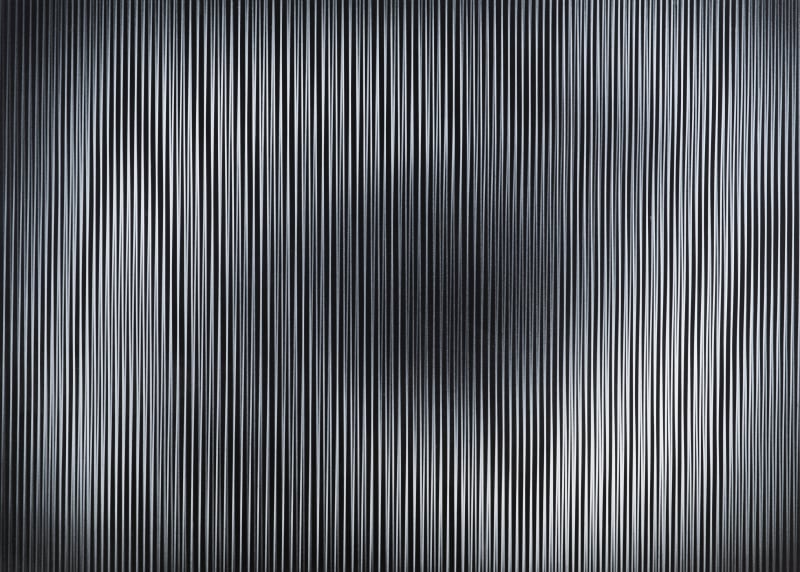 Peter SedgleySeptember, 1982Acrylic on paper71 x 102 cm%3Cdiv%20class%3D%22artist%22%3E%3Cspan%20class%3D%22artist%22%3E%3Cstrong%3EPeter%20Sedgley%3C/strong%3E%3C/span%3E%3C/div%3E%0D%3Cdiv%20class%3D%22title%22%3E%3Cem%3ESeptember%3C/em%3E%2C%201982%3C/div%3E%0D%3Cdiv%20class%3D%22medium%22%3EAcrylic%20on%20paper%3C/div%3E%0D%3Cdiv%20class%3D%22dimensions%22%3E71%20x%20102%20cm%3C/div%3E
Peter SedgleySeptember, 1982Acrylic on paper71 x 102 cm%3Cdiv%20class%3D%22artist%22%3E%3Cspan%20class%3D%22artist%22%3E%3Cstrong%3EPeter%20Sedgley%3C/strong%3E%3C/span%3E%3C/div%3E%0D%3Cdiv%20class%3D%22title%22%3E%3Cem%3ESeptember%3C/em%3E%2C%201982%3C/div%3E%0D%3Cdiv%20class%3D%22medium%22%3EAcrylic%20on%20paper%3C/div%3E%0D%3Cdiv%20class%3D%22dimensions%22%3E71%20x%20102%20cm%3C/div%3E -
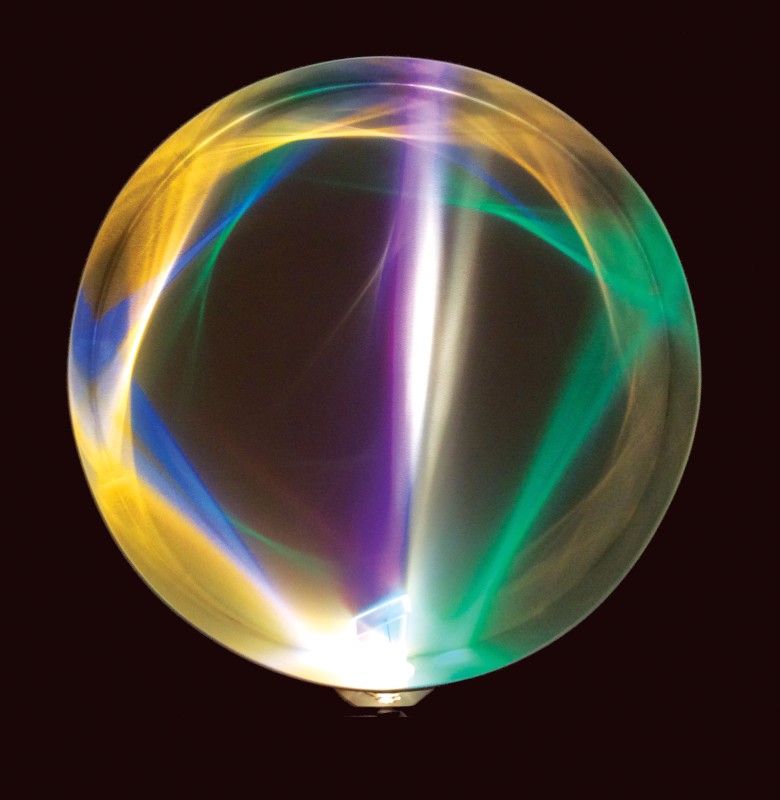 Peter SedgleySpin, 1981Kinetic light work120 x 120 x 17 cm%3Cdiv%20class%3D%22artist%22%3E%3Cspan%20class%3D%22artist%22%3E%3Cstrong%3EPeter%20Sedgley%3C/strong%3E%3C/span%3E%3C/div%3E%0D%3Cdiv%20class%3D%22title%22%3E%3Cem%3ESpin%3C/em%3E%2C%201981%3C/div%3E%0D%3Cdiv%20class%3D%22medium%22%3EKinetic%20light%20work%3C/div%3E%0D%3Cdiv%20class%3D%22dimensions%22%3E120%20x%20120%20x%2017%20cm%3C/div%3E
Peter SedgleySpin, 1981Kinetic light work120 x 120 x 17 cm%3Cdiv%20class%3D%22artist%22%3E%3Cspan%20class%3D%22artist%22%3E%3Cstrong%3EPeter%20Sedgley%3C/strong%3E%3C/span%3E%3C/div%3E%0D%3Cdiv%20class%3D%22title%22%3E%3Cem%3ESpin%3C/em%3E%2C%201981%3C/div%3E%0D%3Cdiv%20class%3D%22medium%22%3EKinetic%20light%20work%3C/div%3E%0D%3Cdiv%20class%3D%22dimensions%22%3E120%20x%20120%20x%2017%20cm%3C/div%3E -
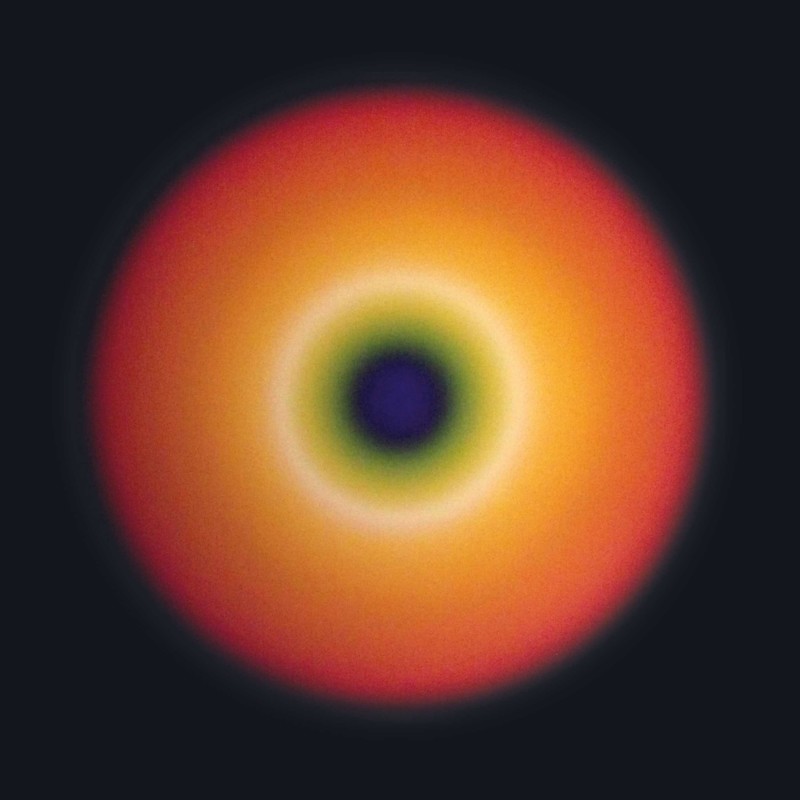 Peter SedgleyBlau Punkt, 1980Acrylic on linen100 x 100 cm%3Cdiv%20class%3D%22artist%22%3E%3Cspan%20class%3D%22artist%22%3E%3Cstrong%3EPeter%20Sedgley%3C/strong%3E%3C/span%3E%3C/div%3E%0D%3Cdiv%20class%3D%22title%22%3E%3Cem%3EBlau%20Punkt%3C/em%3E%2C%201980%3C/div%3E%0D%3Cdiv%20class%3D%22medium%22%3EAcrylic%20on%20linen%3C/div%3E%0D%3Cdiv%20class%3D%22dimensions%22%3E100%20x%20100%20cm%3C/div%3E
Peter SedgleyBlau Punkt, 1980Acrylic on linen100 x 100 cm%3Cdiv%20class%3D%22artist%22%3E%3Cspan%20class%3D%22artist%22%3E%3Cstrong%3EPeter%20Sedgley%3C/strong%3E%3C/span%3E%3C/div%3E%0D%3Cdiv%20class%3D%22title%22%3E%3Cem%3EBlau%20Punkt%3C/em%3E%2C%201980%3C/div%3E%0D%3Cdiv%20class%3D%22medium%22%3EAcrylic%20on%20linen%3C/div%3E%0D%3Cdiv%20class%3D%22dimensions%22%3E100%20x%20100%20cm%3C/div%3E -
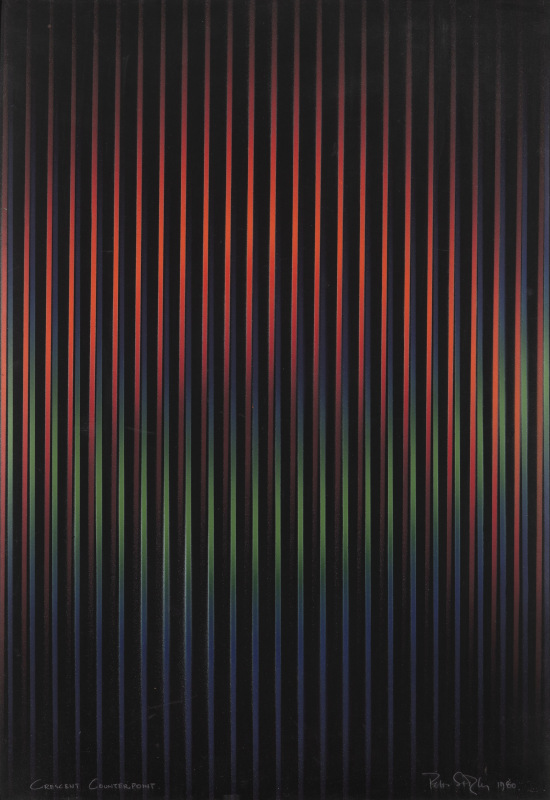 Peter SedgleyCrescent Counterpoint , 1980Acrylic on paper68 x 46.8 cmSigned, dated and titled%3Cdiv%20class%3D%22artist%22%3E%3Cspan%20class%3D%22artist%22%3E%3Cstrong%3EPeter%20Sedgley%3C/strong%3E%3C/span%3E%3C/div%3E%0D%3Cdiv%20class%3D%22title%22%3E%3Cem%3ECrescent%20Counterpoint%20%3C/em%3E%2C%201980%3C/div%3E%0D%3Cdiv%20class%3D%22signed_and_dated%22%3ESigned%2C%20dated%20and%20titled%3C/div%3E%0D%3Cdiv%20class%3D%22medium%22%3EAcrylic%20on%20paper%3C/div%3E%0D%3Cdiv%20class%3D%22dimensions%22%3E68%20x%2046.8%20cm%3C/div%3E
Peter SedgleyCrescent Counterpoint , 1980Acrylic on paper68 x 46.8 cmSigned, dated and titled%3Cdiv%20class%3D%22artist%22%3E%3Cspan%20class%3D%22artist%22%3E%3Cstrong%3EPeter%20Sedgley%3C/strong%3E%3C/span%3E%3C/div%3E%0D%3Cdiv%20class%3D%22title%22%3E%3Cem%3ECrescent%20Counterpoint%20%3C/em%3E%2C%201980%3C/div%3E%0D%3Cdiv%20class%3D%22signed_and_dated%22%3ESigned%2C%20dated%20and%20titled%3C/div%3E%0D%3Cdiv%20class%3D%22medium%22%3EAcrylic%20on%20paper%3C/div%3E%0D%3Cdiv%20class%3D%22dimensions%22%3E68%20x%2046.8%20cm%3C/div%3E -
 Peter SedgleyEnergy, 1980Acrylic on linen150 x 150 cmSigned, dated and titled on reverse%3Cdiv%20class%3D%22artist%22%3E%3Cspan%20class%3D%22artist%22%3E%3Cstrong%3EPeter%20Sedgley%3C/strong%3E%3C/span%3E%3C/div%3E%0D%3Cdiv%20class%3D%22title%22%3E%3Cem%3EEnergy%3C/em%3E%2C%201980%3C/div%3E%0D%3Cdiv%20class%3D%22signed_and_dated%22%3ESigned%2C%20dated%20and%20titled%20on%20reverse%3C/div%3E%0D%3Cdiv%20class%3D%22medium%22%3EAcrylic%20on%20linen%3C/div%3E%0D%3Cdiv%20class%3D%22dimensions%22%3E150%20x%20150%20cm%3C/div%3E
Peter SedgleyEnergy, 1980Acrylic on linen150 x 150 cmSigned, dated and titled on reverse%3Cdiv%20class%3D%22artist%22%3E%3Cspan%20class%3D%22artist%22%3E%3Cstrong%3EPeter%20Sedgley%3C/strong%3E%3C/span%3E%3C/div%3E%0D%3Cdiv%20class%3D%22title%22%3E%3Cem%3EEnergy%3C/em%3E%2C%201980%3C/div%3E%0D%3Cdiv%20class%3D%22signed_and_dated%22%3ESigned%2C%20dated%20and%20titled%20on%20reverse%3C/div%3E%0D%3Cdiv%20class%3D%22medium%22%3EAcrylic%20on%20linen%3C/div%3E%0D%3Cdiv%20class%3D%22dimensions%22%3E150%20x%20150%20cm%3C/div%3E -
 Peter SedgleyEnigma, 1980Acrylic on linen120 x 120 cm%3Cdiv%20class%3D%22artist%22%3E%3Cspan%20class%3D%22artist%22%3E%3Cstrong%3EPeter%20Sedgley%3C/strong%3E%3C/span%3E%3C/div%3E%0D%3Cdiv%20class%3D%22title%22%3E%3Cem%3EEnigma%3C/em%3E%2C%201980%3C/div%3E%0D%3Cdiv%20class%3D%22medium%22%3EAcrylic%20on%20linen%3C/div%3E%0D%3Cdiv%20class%3D%22dimensions%22%3E120%20x%20120%20cm%3C/div%3E
Peter SedgleyEnigma, 1980Acrylic on linen120 x 120 cm%3Cdiv%20class%3D%22artist%22%3E%3Cspan%20class%3D%22artist%22%3E%3Cstrong%3EPeter%20Sedgley%3C/strong%3E%3C/span%3E%3C/div%3E%0D%3Cdiv%20class%3D%22title%22%3E%3Cem%3EEnigma%3C/em%3E%2C%201980%3C/div%3E%0D%3Cdiv%20class%3D%22medium%22%3EAcrylic%20on%20linen%3C/div%3E%0D%3Cdiv%20class%3D%22dimensions%22%3E120%20x%20120%20cm%3C/div%3E -
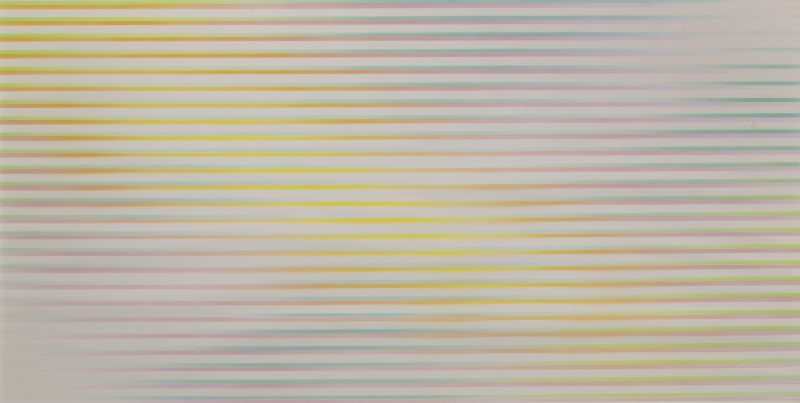 Peter SedgleyHigh Key, 1980Acrylic on paper51 x 99 cmSigned, dated and titled verso%3Cdiv%20class%3D%22artist%22%3E%3Cspan%20class%3D%22artist%22%3E%3Cstrong%3EPeter%20Sedgley%3C/strong%3E%3C/span%3E%3C/div%3E%0D%3Cdiv%20class%3D%22title%22%3E%3Cem%3EHigh%20Key%3C/em%3E%2C%201980%3C/div%3E%0D%3Cdiv%20class%3D%22signed_and_dated%22%3ESigned%2C%20dated%20and%20titled%20verso%20%3C/div%3E%0D%3Cdiv%20class%3D%22medium%22%3EAcrylic%20on%20paper%3C/div%3E%0D%3Cdiv%20class%3D%22dimensions%22%3E51%20x%2099%20cm%3C/div%3E
Peter SedgleyHigh Key, 1980Acrylic on paper51 x 99 cmSigned, dated and titled verso%3Cdiv%20class%3D%22artist%22%3E%3Cspan%20class%3D%22artist%22%3E%3Cstrong%3EPeter%20Sedgley%3C/strong%3E%3C/span%3E%3C/div%3E%0D%3Cdiv%20class%3D%22title%22%3E%3Cem%3EHigh%20Key%3C/em%3E%2C%201980%3C/div%3E%0D%3Cdiv%20class%3D%22signed_and_dated%22%3ESigned%2C%20dated%20and%20titled%20verso%20%3C/div%3E%0D%3Cdiv%20class%3D%22medium%22%3EAcrylic%20on%20paper%3C/div%3E%0D%3Cdiv%20class%3D%22dimensions%22%3E51%20x%2099%20cm%3C/div%3E -
 Peter SedgleyOvertones, 1980Acrylic on card51 x 97 cmSigned, dated and titled on reverse%3Cdiv%20class%3D%22artist%22%3E%3Cspan%20class%3D%22artist%22%3E%3Cstrong%3EPeter%20Sedgley%3C/strong%3E%3C/span%3E%3C/div%3E%0D%3Cdiv%20class%3D%22title%22%3E%3Cem%3EOvertones%3C/em%3E%2C%201980%3C/div%3E%0D%3Cdiv%20class%3D%22signed_and_dated%22%3ESigned%2C%20dated%20and%20titled%20on%20reverse%20%3C/div%3E%0D%3Cdiv%20class%3D%22medium%22%3EAcrylic%20on%20card%3C/div%3E%0D%3Cdiv%20class%3D%22dimensions%22%3E51%20x%2097%20cm%3C/div%3E
Peter SedgleyOvertones, 1980Acrylic on card51 x 97 cmSigned, dated and titled on reverse%3Cdiv%20class%3D%22artist%22%3E%3Cspan%20class%3D%22artist%22%3E%3Cstrong%3EPeter%20Sedgley%3C/strong%3E%3C/span%3E%3C/div%3E%0D%3Cdiv%20class%3D%22title%22%3E%3Cem%3EOvertones%3C/em%3E%2C%201980%3C/div%3E%0D%3Cdiv%20class%3D%22signed_and_dated%22%3ESigned%2C%20dated%20and%20titled%20on%20reverse%20%3C/div%3E%0D%3Cdiv%20class%3D%22medium%22%3EAcrylic%20on%20card%3C/div%3E%0D%3Cdiv%20class%3D%22dimensions%22%3E51%20x%2097%20cm%3C/div%3E -
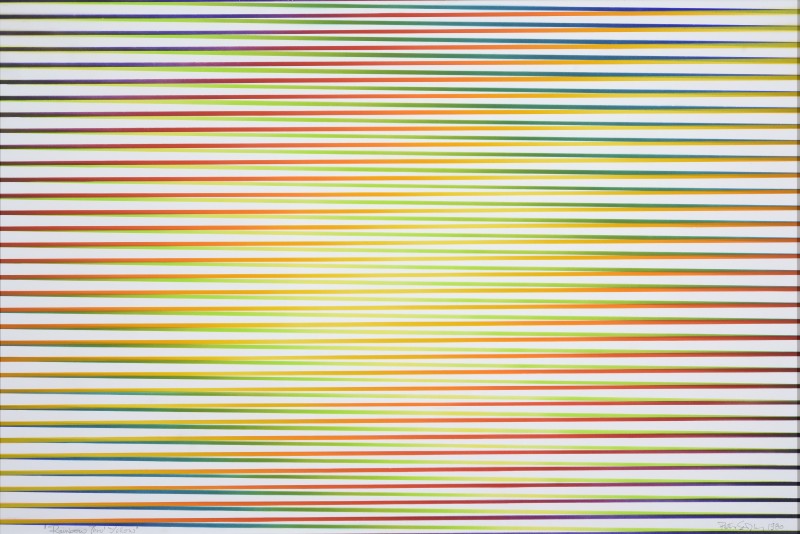 Peter SedgleyRainbow, thru' Yellow, 1980Acrylic on card65 x 97 cmSigned and dated lower right; titled lower left%3Cdiv%20class%3D%22artist%22%3E%3Cspan%20class%3D%22artist%22%3E%3Cstrong%3EPeter%20Sedgley%3C/strong%3E%3C/span%3E%3C/div%3E%0D%3Cdiv%20class%3D%22title%22%3E%3Cem%3ERainbow%2C%20thru%27%20Yellow%3C/em%3E%2C%201980%3C/div%3E%0D%3Cdiv%20class%3D%22signed_and_dated%22%3ESigned%20and%20dated%20lower%20right%3B%20titled%20lower%20left%3C/div%3E%0D%3Cdiv%20class%3D%22medium%22%3EAcrylic%20on%20card%3C/div%3E%0D%3Cdiv%20class%3D%22dimensions%22%3E65%20x%2097%20cm%3C/div%3E
Peter SedgleyRainbow, thru' Yellow, 1980Acrylic on card65 x 97 cmSigned and dated lower right; titled lower left%3Cdiv%20class%3D%22artist%22%3E%3Cspan%20class%3D%22artist%22%3E%3Cstrong%3EPeter%20Sedgley%3C/strong%3E%3C/span%3E%3C/div%3E%0D%3Cdiv%20class%3D%22title%22%3E%3Cem%3ERainbow%2C%20thru%27%20Yellow%3C/em%3E%2C%201980%3C/div%3E%0D%3Cdiv%20class%3D%22signed_and_dated%22%3ESigned%20and%20dated%20lower%20right%3B%20titled%20lower%20left%3C/div%3E%0D%3Cdiv%20class%3D%22medium%22%3EAcrylic%20on%20card%3C/div%3E%0D%3Cdiv%20class%3D%22dimensions%22%3E65%20x%2097%20cm%3C/div%3E -
 Peter SedgleyWeightless, 1980Acrylic on paper50 x 46 cmSigned, dated and titled lower left%3Cdiv%20class%3D%22artist%22%3E%3Cspan%20class%3D%22artist%22%3E%3Cstrong%3EPeter%20Sedgley%3C/strong%3E%3C/span%3E%3C/div%3E%0D%3Cdiv%20class%3D%22title%22%3E%3Cem%3EWeightless%3C/em%3E%2C%201980%3C/div%3E%0D%3Cdiv%20class%3D%22signed_and_dated%22%3ESigned%2C%20dated%20and%20titled%20lower%20left%3C/div%3E%0D%3Cdiv%20class%3D%22medium%22%3EAcrylic%20on%20paper%3C/div%3E%0D%3Cdiv%20class%3D%22dimensions%22%3E50%20x%2046%20cm%3C/div%3E
Peter SedgleyWeightless, 1980Acrylic on paper50 x 46 cmSigned, dated and titled lower left%3Cdiv%20class%3D%22artist%22%3E%3Cspan%20class%3D%22artist%22%3E%3Cstrong%3EPeter%20Sedgley%3C/strong%3E%3C/span%3E%3C/div%3E%0D%3Cdiv%20class%3D%22title%22%3E%3Cem%3EWeightless%3C/em%3E%2C%201980%3C/div%3E%0D%3Cdiv%20class%3D%22signed_and_dated%22%3ESigned%2C%20dated%20and%20titled%20lower%20left%3C/div%3E%0D%3Cdiv%20class%3D%22medium%22%3EAcrylic%20on%20paper%3C/div%3E%0D%3Cdiv%20class%3D%22dimensions%22%3E50%20x%2046%20cm%3C/div%3E -
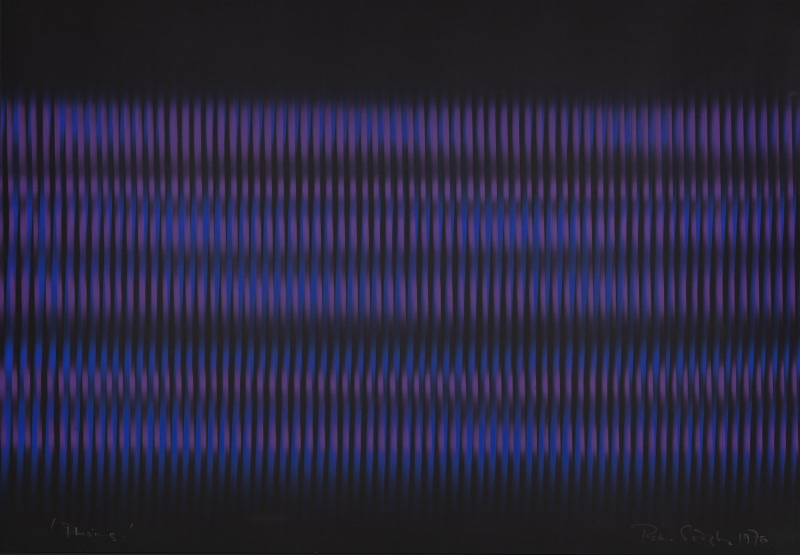 Peter SedgleyPhasing I , 1979Acrylic on paper48 x 69 cmSigned, titled and dated%3Cdiv%20class%3D%22artist%22%3E%3Cspan%20class%3D%22artist%22%3E%3Cstrong%3EPeter%20Sedgley%3C/strong%3E%3C/span%3E%3C/div%3E%0D%3Cdiv%20class%3D%22title%22%3E%3Cem%3EPhasing%20I%20%3C/em%3E%2C%201979%3C/div%3E%0D%3Cdiv%20class%3D%22signed_and_dated%22%3ESigned%2C%20titled%20and%20dated%3C/div%3E%0D%3Cdiv%20class%3D%22medium%22%3EAcrylic%20on%20paper%3C/div%3E%0D%3Cdiv%20class%3D%22dimensions%22%3E48%20x%2069%20cm%3C/div%3E
Peter SedgleyPhasing I , 1979Acrylic on paper48 x 69 cmSigned, titled and dated%3Cdiv%20class%3D%22artist%22%3E%3Cspan%20class%3D%22artist%22%3E%3Cstrong%3EPeter%20Sedgley%3C/strong%3E%3C/span%3E%3C/div%3E%0D%3Cdiv%20class%3D%22title%22%3E%3Cem%3EPhasing%20I%20%3C/em%3E%2C%201979%3C/div%3E%0D%3Cdiv%20class%3D%22signed_and_dated%22%3ESigned%2C%20titled%20and%20dated%3C/div%3E%0D%3Cdiv%20class%3D%22medium%22%3EAcrylic%20on%20paper%3C/div%3E%0D%3Cdiv%20class%3D%22dimensions%22%3E48%20x%2069%20cm%3C/div%3E -
 Peter SedgleyPhasing II, 1979Acrylic on paper48 x 69 cmSigned, titled and dated%3Cdiv%20class%3D%22artist%22%3E%3Cspan%20class%3D%22artist%22%3E%3Cstrong%3EPeter%20Sedgley%3C/strong%3E%3C/span%3E%3C/div%3E%0D%3Cdiv%20class%3D%22title%22%3E%3Cem%3EPhasing%20II%3C/em%3E%2C%201979%3C/div%3E%0D%3Cdiv%20class%3D%22signed_and_dated%22%3ESigned%2C%20titled%20and%20dated%3C/div%3E%0D%3Cdiv%20class%3D%22medium%22%3EAcrylic%20on%20paper%3C/div%3E%0D%3Cdiv%20class%3D%22dimensions%22%3E48%20x%2069%20cm%3C/div%3E
Peter SedgleyPhasing II, 1979Acrylic on paper48 x 69 cmSigned, titled and dated%3Cdiv%20class%3D%22artist%22%3E%3Cspan%20class%3D%22artist%22%3E%3Cstrong%3EPeter%20Sedgley%3C/strong%3E%3C/span%3E%3C/div%3E%0D%3Cdiv%20class%3D%22title%22%3E%3Cem%3EPhasing%20II%3C/em%3E%2C%201979%3C/div%3E%0D%3Cdiv%20class%3D%22signed_and_dated%22%3ESigned%2C%20titled%20and%20dated%3C/div%3E%0D%3Cdiv%20class%3D%22medium%22%3EAcrylic%20on%20paper%3C/div%3E%0D%3Cdiv%20class%3D%22dimensions%22%3E48%20x%2069%20cm%3C/div%3E -
 Peter SedgleyClouded Circle No. 2, 1976Gouache on paper31 x 31 cmSigned and dated lower right; titled lower left%3Cdiv%20class%3D%22artist%22%3E%3Cspan%20class%3D%22artist%22%3E%3Cstrong%3EPeter%20Sedgley%3C/strong%3E%3C/span%3E%3C/div%3E%0D%3Cdiv%20class%3D%22title%22%3E%3Cem%3EClouded%20Circle%20No.%202%3C/em%3E%2C%201976%3C/div%3E%0D%3Cdiv%20class%3D%22signed_and_dated%22%3ESigned%20and%20dated%20lower%20right%3B%20titled%20lower%20left%3C/div%3E%0D%3Cdiv%20class%3D%22medium%22%3EGouache%20on%20paper%3C/div%3E%0D%3Cdiv%20class%3D%22dimensions%22%3E31%20x%2031%20cm%3C/div%3E
Peter SedgleyClouded Circle No. 2, 1976Gouache on paper31 x 31 cmSigned and dated lower right; titled lower left%3Cdiv%20class%3D%22artist%22%3E%3Cspan%20class%3D%22artist%22%3E%3Cstrong%3EPeter%20Sedgley%3C/strong%3E%3C/span%3E%3C/div%3E%0D%3Cdiv%20class%3D%22title%22%3E%3Cem%3EClouded%20Circle%20No.%202%3C/em%3E%2C%201976%3C/div%3E%0D%3Cdiv%20class%3D%22signed_and_dated%22%3ESigned%20and%20dated%20lower%20right%3B%20titled%20lower%20left%3C/div%3E%0D%3Cdiv%20class%3D%22medium%22%3EGouache%20on%20paper%3C/div%3E%0D%3Cdiv%20class%3D%22dimensions%22%3E31%20x%2031%20cm%3C/div%3E -
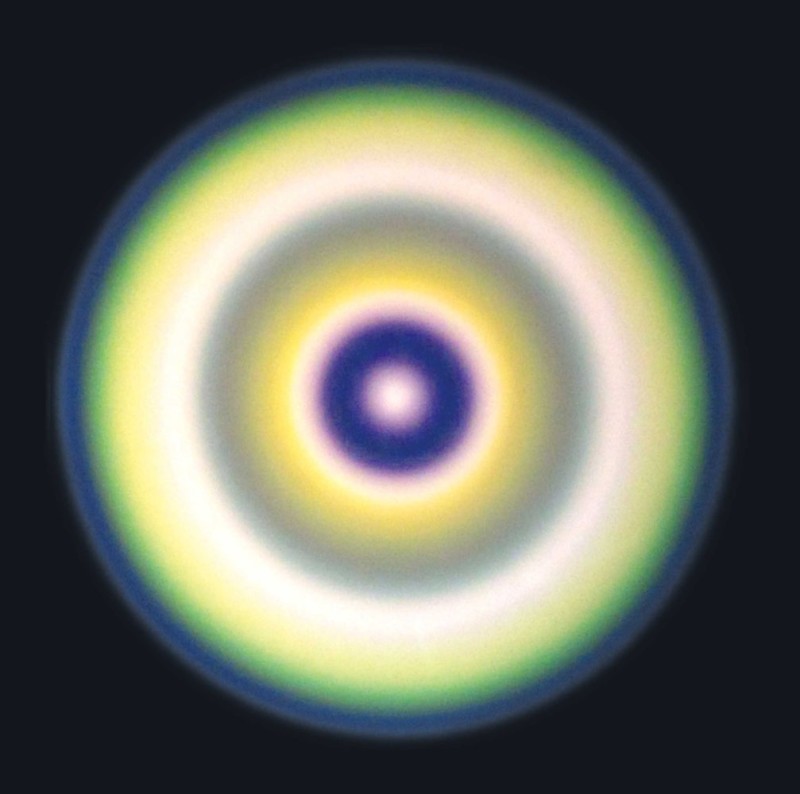 Peter SedgleyPolar Light Energy, 1973Acrylic on linen150 x 150 cmSigned, dated and titled verso%3Cdiv%20class%3D%22artist%22%3E%3Cspan%20class%3D%22artist%22%3E%3Cstrong%3EPeter%20Sedgley%3C/strong%3E%3C/span%3E%3C/div%3E%0D%3Cdiv%20class%3D%22title%22%3E%3Cem%3EPolar%20Light%20Energy%3C/em%3E%2C%201973%3C/div%3E%0D%3Cdiv%20class%3D%22signed_and_dated%22%3ESigned%2C%20dated%20and%20titled%20verso%3C/div%3E%0D%3Cdiv%20class%3D%22medium%22%3EAcrylic%20on%20linen%20%3C/div%3E%0D%3Cdiv%20class%3D%22dimensions%22%3E150%20x%20150%20cm%20%3C/div%3E
Peter SedgleyPolar Light Energy, 1973Acrylic on linen150 x 150 cmSigned, dated and titled verso%3Cdiv%20class%3D%22artist%22%3E%3Cspan%20class%3D%22artist%22%3E%3Cstrong%3EPeter%20Sedgley%3C/strong%3E%3C/span%3E%3C/div%3E%0D%3Cdiv%20class%3D%22title%22%3E%3Cem%3EPolar%20Light%20Energy%3C/em%3E%2C%201973%3C/div%3E%0D%3Cdiv%20class%3D%22signed_and_dated%22%3ESigned%2C%20dated%20and%20titled%20verso%3C/div%3E%0D%3Cdiv%20class%3D%22medium%22%3EAcrylic%20on%20linen%20%3C/div%3E%0D%3Cdiv%20class%3D%22dimensions%22%3E150%20x%20150%20cm%20%3C/div%3E -
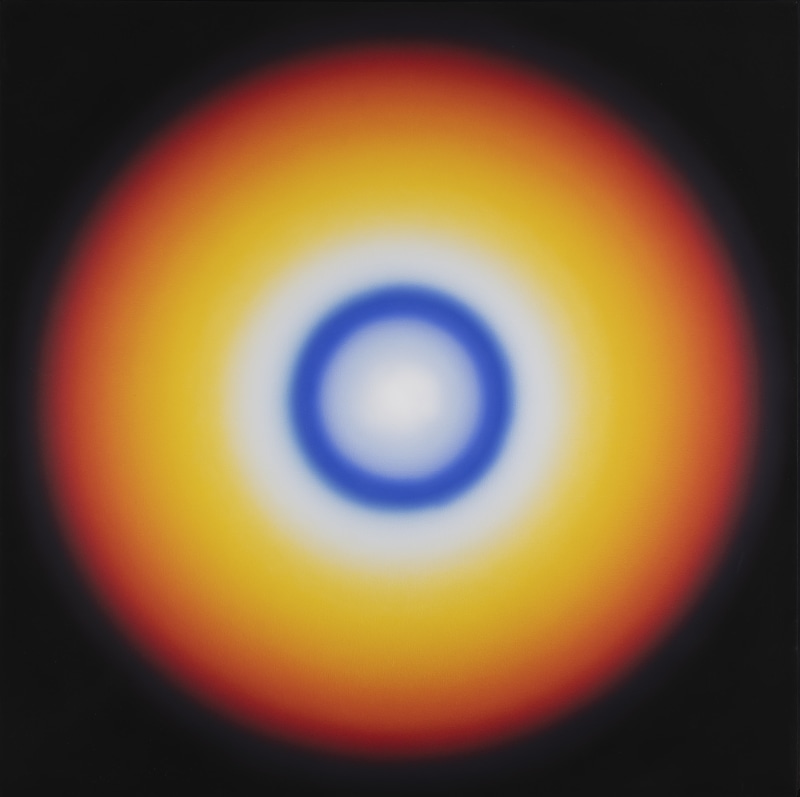 Peter SedgleyRed Nebula, 1973PVA and fluorescent colour on canvas150 x 150 x 4 cmSigned, dated and titled on reverse%3Cdiv%20class%3D%22artist%22%3E%3Cspan%20class%3D%22artist%22%3E%3Cstrong%3EPeter%20Sedgley%3C/strong%3E%3C/span%3E%3C/div%3E%0D%3Cdiv%20class%3D%22title%22%3E%3Cem%3ERed%20Nebula%3C/em%3E%2C%201973%3C/div%3E%0D%3Cdiv%20class%3D%22signed_and_dated%22%3ESigned%2C%20dated%20and%20titled%20on%20reverse%3C/div%3E%0D%3Cdiv%20class%3D%22medium%22%3EPVA%20and%20fluorescent%20colour%20on%20canvas%3C/div%3E%0D%3Cdiv%20class%3D%22dimensions%22%3E150%20x%20150%20x%204%20cm%3C/div%3E
Peter SedgleyRed Nebula, 1973PVA and fluorescent colour on canvas150 x 150 x 4 cmSigned, dated and titled on reverse%3Cdiv%20class%3D%22artist%22%3E%3Cspan%20class%3D%22artist%22%3E%3Cstrong%3EPeter%20Sedgley%3C/strong%3E%3C/span%3E%3C/div%3E%0D%3Cdiv%20class%3D%22title%22%3E%3Cem%3ERed%20Nebula%3C/em%3E%2C%201973%3C/div%3E%0D%3Cdiv%20class%3D%22signed_and_dated%22%3ESigned%2C%20dated%20and%20titled%20on%20reverse%3C/div%3E%0D%3Cdiv%20class%3D%22medium%22%3EPVA%20and%20fluorescent%20colour%20on%20canvas%3C/div%3E%0D%3Cdiv%20class%3D%22dimensions%22%3E150%20x%20150%20x%204%20cm%3C/div%3E -
 Peter SedgleyFirebird - Black , 1969Low fired porcelain with coloured glazes30 x 30 cm%3Cdiv%20class%3D%22artist%22%3E%3Cspan%20class%3D%22artist%22%3E%3Cstrong%3EPeter%20Sedgley%3C/strong%3E%3C/span%3E%3C/div%3E%0D%3Cdiv%20class%3D%22title%22%3E%3Cem%3EFirebird%20-%20Black%20%3C/em%3E%2C%201969%3C/div%3E%0D%3Cdiv%20class%3D%22medium%22%3ELow%20fired%20porcelain%20with%20coloured%20glazes%3C/div%3E%0D%3Cdiv%20class%3D%22dimensions%22%3E30%20x%2030%20cm%3C/div%3E
Peter SedgleyFirebird - Black , 1969Low fired porcelain with coloured glazes30 x 30 cm%3Cdiv%20class%3D%22artist%22%3E%3Cspan%20class%3D%22artist%22%3E%3Cstrong%3EPeter%20Sedgley%3C/strong%3E%3C/span%3E%3C/div%3E%0D%3Cdiv%20class%3D%22title%22%3E%3Cem%3EFirebird%20-%20Black%20%3C/em%3E%2C%201969%3C/div%3E%0D%3Cdiv%20class%3D%22medium%22%3ELow%20fired%20porcelain%20with%20coloured%20glazes%3C/div%3E%0D%3Cdiv%20class%3D%22dimensions%22%3E30%20x%2030%20cm%3C/div%3E -
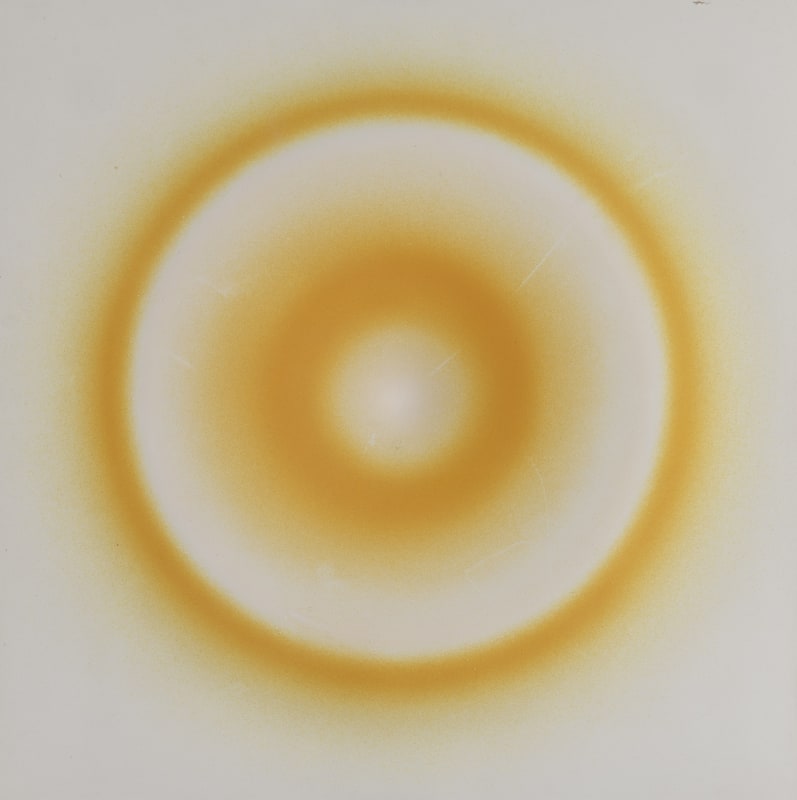 Peter SedgleyFirebird - Yellow, 1969Low fired porcelain with coloured glass32 x 32 cm%3Cdiv%20class%3D%22artist%22%3E%3Cspan%20class%3D%22artist%22%3E%3Cstrong%3EPeter%20Sedgley%3C/strong%3E%3C/span%3E%3C/div%3E%0D%3Cdiv%20class%3D%22title%22%3E%3Cem%3EFirebird%20-%20Yellow%3C/em%3E%2C%201969%3C/div%3E%0D%3Cdiv%20class%3D%22medium%22%3ELow%20fired%20porcelain%20with%20coloured%20glass%3C/div%3E%0D%3Cdiv%20class%3D%22dimensions%22%3E32%20x%2032%20cm%3C/div%3E
Peter SedgleyFirebird - Yellow, 1969Low fired porcelain with coloured glass32 x 32 cm%3Cdiv%20class%3D%22artist%22%3E%3Cspan%20class%3D%22artist%22%3E%3Cstrong%3EPeter%20Sedgley%3C/strong%3E%3C/span%3E%3C/div%3E%0D%3Cdiv%20class%3D%22title%22%3E%3Cem%3EFirebird%20-%20Yellow%3C/em%3E%2C%201969%3C/div%3E%0D%3Cdiv%20class%3D%22medium%22%3ELow%20fired%20porcelain%20with%20coloured%20glass%3C/div%3E%0D%3Cdiv%20class%3D%22dimensions%22%3E32%20x%2032%20cm%3C/div%3E -
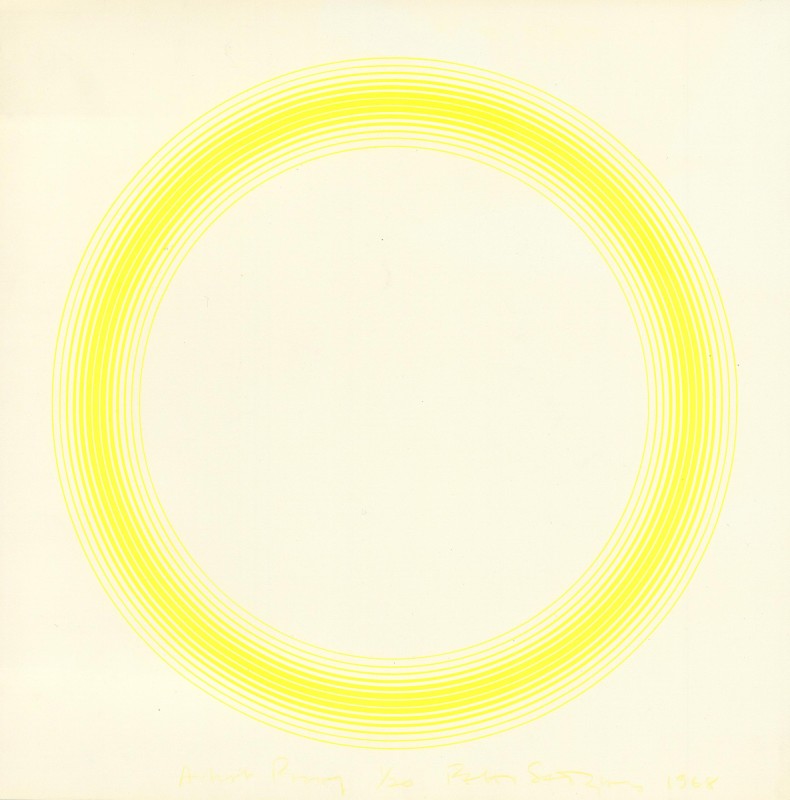 Peter SedgleyUntitled, 1968Screenprint32 x 32 cmFrom the edition of 20 impressionsSigned, dated, and numbered%3Cdiv%20class%3D%22artist%22%3E%3Cspan%20class%3D%22artist%22%3E%3Cstrong%3EPeter%20Sedgley%3C/strong%3E%3C/span%3E%3C/div%3E%0D%3Cdiv%20class%3D%22title%22%3E%3Cem%3EUntitled%3C/em%3E%2C%201968%3C/div%3E%0D%3Cdiv%20class%3D%22signed_and_dated%22%3ESigned%2C%20dated%2C%20and%20numbered%3C/div%3E%0D%3Cdiv%20class%3D%22medium%22%3EScreenprint%20%3C/div%3E%0D%3Cdiv%20class%3D%22dimensions%22%3E32%20x%2032%20cm%3C/div%3E%0D%3Cdiv%20class%3D%22edition_details%22%3EFrom%20the%20edition%20of%2020%20impressions%3C/div%3E
Peter SedgleyUntitled, 1968Screenprint32 x 32 cmFrom the edition of 20 impressionsSigned, dated, and numbered%3Cdiv%20class%3D%22artist%22%3E%3Cspan%20class%3D%22artist%22%3E%3Cstrong%3EPeter%20Sedgley%3C/strong%3E%3C/span%3E%3C/div%3E%0D%3Cdiv%20class%3D%22title%22%3E%3Cem%3EUntitled%3C/em%3E%2C%201968%3C/div%3E%0D%3Cdiv%20class%3D%22signed_and_dated%22%3ESigned%2C%20dated%2C%20and%20numbered%3C/div%3E%0D%3Cdiv%20class%3D%22medium%22%3EScreenprint%20%3C/div%3E%0D%3Cdiv%20class%3D%22dimensions%22%3E32%20x%2032%20cm%3C/div%3E%0D%3Cdiv%20class%3D%22edition_details%22%3EFrom%20the%20edition%20of%2020%20impressions%3C/div%3E -
 Peter SedgleyConstellation, 1966PVA on canvas51 x 51 cmSigned, dated and titled verso%3Cdiv%20class%3D%22artist%22%3E%3Cspan%20class%3D%22artist%22%3E%3Cstrong%3EPeter%20Sedgley%3C/strong%3E%3C/span%3E%3C/div%3E%0D%3Cdiv%20class%3D%22title%22%3E%3Cem%3EConstellation%3C/em%3E%2C%201966%3C/div%3E%0D%3Cdiv%20class%3D%22signed_and_dated%22%3ESigned%2C%20dated%20and%20titled%20verso%3C/div%3E%0D%3Cdiv%20class%3D%22medium%22%3EPVA%20on%20canvas%3C/div%3E%0D%3Cdiv%20class%3D%22dimensions%22%3E51%20x%2051%20cm%3C/div%3E
Peter SedgleyConstellation, 1966PVA on canvas51 x 51 cmSigned, dated and titled verso%3Cdiv%20class%3D%22artist%22%3E%3Cspan%20class%3D%22artist%22%3E%3Cstrong%3EPeter%20Sedgley%3C/strong%3E%3C/span%3E%3C/div%3E%0D%3Cdiv%20class%3D%22title%22%3E%3Cem%3EConstellation%3C/em%3E%2C%201966%3C/div%3E%0D%3Cdiv%20class%3D%22signed_and_dated%22%3ESigned%2C%20dated%20and%20titled%20verso%3C/div%3E%0D%3Cdiv%20class%3D%22medium%22%3EPVA%20on%20canvas%3C/div%3E%0D%3Cdiv%20class%3D%22dimensions%22%3E51%20x%2051%20cm%3C/div%3E -
 Peter SedgleyDapple, 1966Acrylic on canvas154 x 152.2 cmSigned, dated and titled on reverse%3Cdiv%20class%3D%22artist%22%3E%3Cspan%20class%3D%22artist%22%3E%3Cstrong%3EPeter%20Sedgley%3C/strong%3E%3C/span%3E%3C/div%3E%0D%3Cdiv%20class%3D%22title%22%3E%3Cem%3EDapple%3C/em%3E%2C%201966%3C/div%3E%0D%3Cdiv%20class%3D%22signed_and_dated%22%3ESigned%2C%20dated%20and%20titled%20on%20reverse%3C/div%3E%0D%3Cdiv%20class%3D%22medium%22%3EAcrylic%20on%20canvas%3C/div%3E%0D%3Cdiv%20class%3D%22dimensions%22%3E154%20x%20152.2%20cm%3C/div%3E
Peter SedgleyDapple, 1966Acrylic on canvas154 x 152.2 cmSigned, dated and titled on reverse%3Cdiv%20class%3D%22artist%22%3E%3Cspan%20class%3D%22artist%22%3E%3Cstrong%3EPeter%20Sedgley%3C/strong%3E%3C/span%3E%3C/div%3E%0D%3Cdiv%20class%3D%22title%22%3E%3Cem%3EDapple%3C/em%3E%2C%201966%3C/div%3E%0D%3Cdiv%20class%3D%22signed_and_dated%22%3ESigned%2C%20dated%20and%20titled%20on%20reverse%3C/div%3E%0D%3Cdiv%20class%3D%22medium%22%3EAcrylic%20on%20canvas%3C/div%3E%0D%3Cdiv%20class%3D%22dimensions%22%3E154%20x%20152.2%20cm%3C/div%3E -
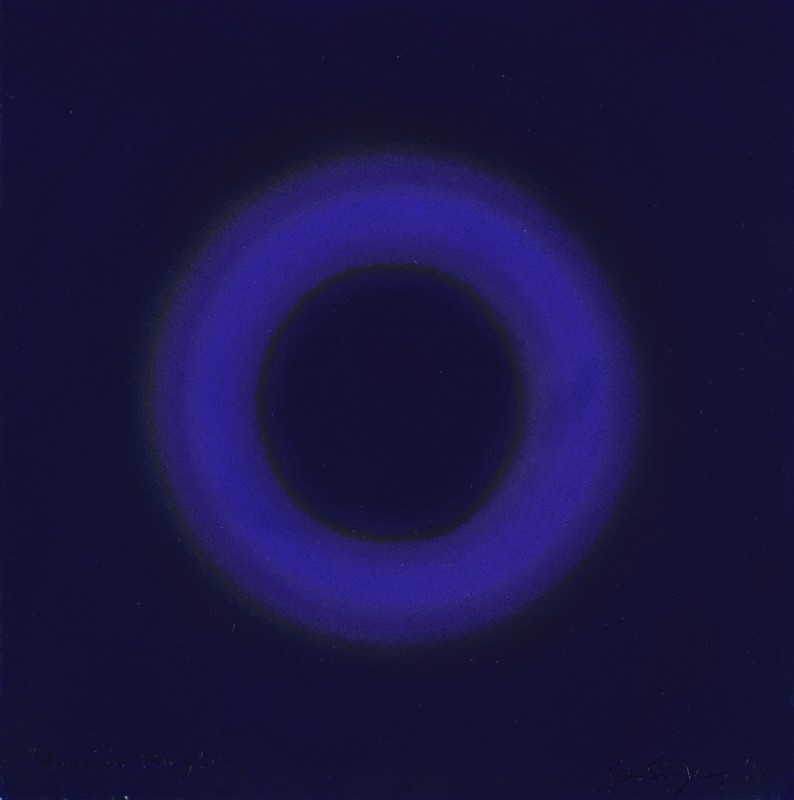 Peter SedgleyPrussian Ring, 1966Acrylic on paper25 x 25 cmSigned and dated lower right; titled lower left%3Cdiv%20class%3D%22artist%22%3E%3Cspan%20class%3D%22artist%22%3E%3Cstrong%3EPeter%20Sedgley%3C/strong%3E%3C/span%3E%3C/div%3E%0D%3Cdiv%20class%3D%22title%22%3E%3Cem%3EPrussian%20Ring%3C/em%3E%2C%201966%3C/div%3E%0D%3Cdiv%20class%3D%22signed_and_dated%22%3ESigned%20and%20dated%20lower%20right%3B%20titled%20lower%20left%3C/div%3E%0D%3Cdiv%20class%3D%22medium%22%3EAcrylic%20on%20paper%3C/div%3E%0D%3Cdiv%20class%3D%22dimensions%22%3E25%20x%2025%20cm%3C/div%3E
Peter SedgleyPrussian Ring, 1966Acrylic on paper25 x 25 cmSigned and dated lower right; titled lower left%3Cdiv%20class%3D%22artist%22%3E%3Cspan%20class%3D%22artist%22%3E%3Cstrong%3EPeter%20Sedgley%3C/strong%3E%3C/span%3E%3C/div%3E%0D%3Cdiv%20class%3D%22title%22%3E%3Cem%3EPrussian%20Ring%3C/em%3E%2C%201966%3C/div%3E%0D%3Cdiv%20class%3D%22signed_and_dated%22%3ESigned%20and%20dated%20lower%20right%3B%20titled%20lower%20left%3C/div%3E%0D%3Cdiv%20class%3D%22medium%22%3EAcrylic%20on%20paper%3C/div%3E%0D%3Cdiv%20class%3D%22dimensions%22%3E25%20x%2025%20cm%3C/div%3E -
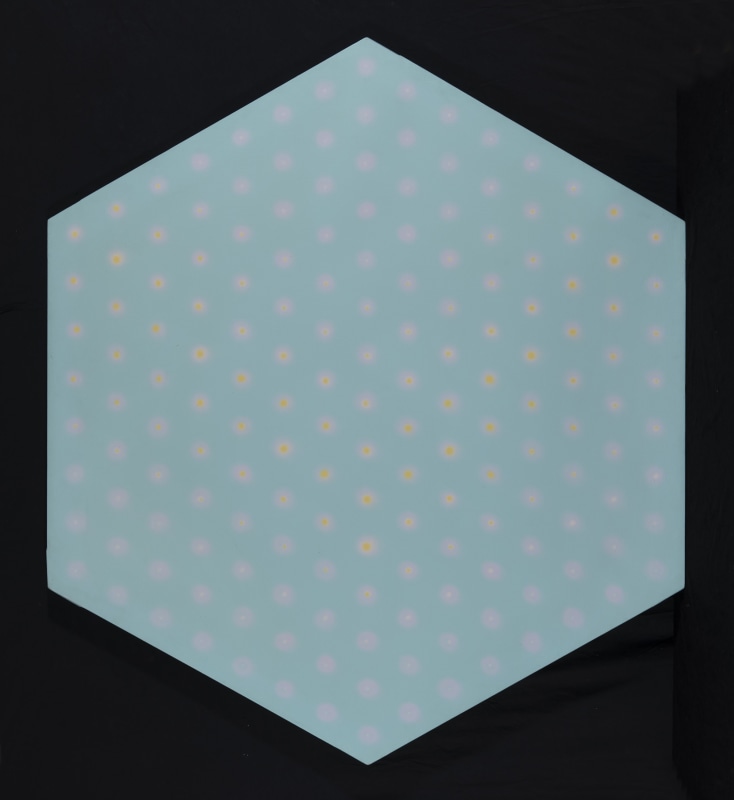 Peter SedgleyTouch, 1966Acrylic on canvas133.5 x 152 cm%3Cdiv%20class%3D%22artist%22%3E%3Cspan%20class%3D%22artist%22%3E%3Cstrong%3EPeter%20Sedgley%3C/strong%3E%3C/span%3E%3C/div%3E%0D%3Cdiv%20class%3D%22title%22%3E%3Cem%3ETouch%3C/em%3E%2C%201966%3C/div%3E%0D%3Cdiv%20class%3D%22medium%22%3EAcrylic%20on%20canvas%3C/div%3E%0D%3Cdiv%20class%3D%22dimensions%22%3E133.5%20x%20152%20cm%3C/div%3E
Peter SedgleyTouch, 1966Acrylic on canvas133.5 x 152 cm%3Cdiv%20class%3D%22artist%22%3E%3Cspan%20class%3D%22artist%22%3E%3Cstrong%3EPeter%20Sedgley%3C/strong%3E%3C/span%3E%3C/div%3E%0D%3Cdiv%20class%3D%22title%22%3E%3Cem%3ETouch%3C/em%3E%2C%201966%3C/div%3E%0D%3Cdiv%20class%3D%22medium%22%3EAcrylic%20on%20canvas%3C/div%3E%0D%3Cdiv%20class%3D%22dimensions%22%3E133.5%20x%20152%20cm%3C/div%3E -
 Peter SedgleyBinaries , 1965Gouache on paper31 x 37.5 cm%3Cdiv%20class%3D%22artist%22%3E%3Cspan%20class%3D%22artist%22%3E%3Cstrong%3EPeter%20Sedgley%3C/strong%3E%3C/span%3E%3C/div%3E%0D%3Cdiv%20class%3D%22title%22%3E%3Cem%3EBinaries%20%3C/em%3E%2C%201965%3C/div%3E%0D%3Cdiv%20class%3D%22medium%22%3EGouache%20on%20paper%3C/div%3E%0D%3Cdiv%20class%3D%22dimensions%22%3E31%20x%2037.5%20cm%3C/div%3E
Peter SedgleyBinaries , 1965Gouache on paper31 x 37.5 cm%3Cdiv%20class%3D%22artist%22%3E%3Cspan%20class%3D%22artist%22%3E%3Cstrong%3EPeter%20Sedgley%3C/strong%3E%3C/span%3E%3C/div%3E%0D%3Cdiv%20class%3D%22title%22%3E%3Cem%3EBinaries%20%3C/em%3E%2C%201965%3C/div%3E%0D%3Cdiv%20class%3D%22medium%22%3EGouache%20on%20paper%3C/div%3E%0D%3Cdiv%20class%3D%22dimensions%22%3E31%20x%2037.5%20cm%3C/div%3E -
Peter SedgleyCounter, 1965Acrylic on canvas150 x 130 cmSigned, dated and titled on reverse%3Cdiv%20class%3D%22artist%22%3E%3Cspan%20class%3D%22artist%22%3E%3Cstrong%3EPeter%20Sedgley%3C/strong%3E%3C/span%3E%3C/div%3E%0D%3Cdiv%20class%3D%22title%22%3E%3Cem%3ECounter%3C/em%3E%2C%201965%3C/div%3E%0D%3Cdiv%20class%3D%22signed_and_dated%22%3ESigned%2C%20dated%20and%20titled%20on%20reverse%3C/div%3E%0D%3Cdiv%20class%3D%22medium%22%3EAcrylic%20on%20canvas%3C/div%3E%0D%3Cdiv%20class%3D%22dimensions%22%3E150%20x%20130%20cm%20%3C/div%3E
-
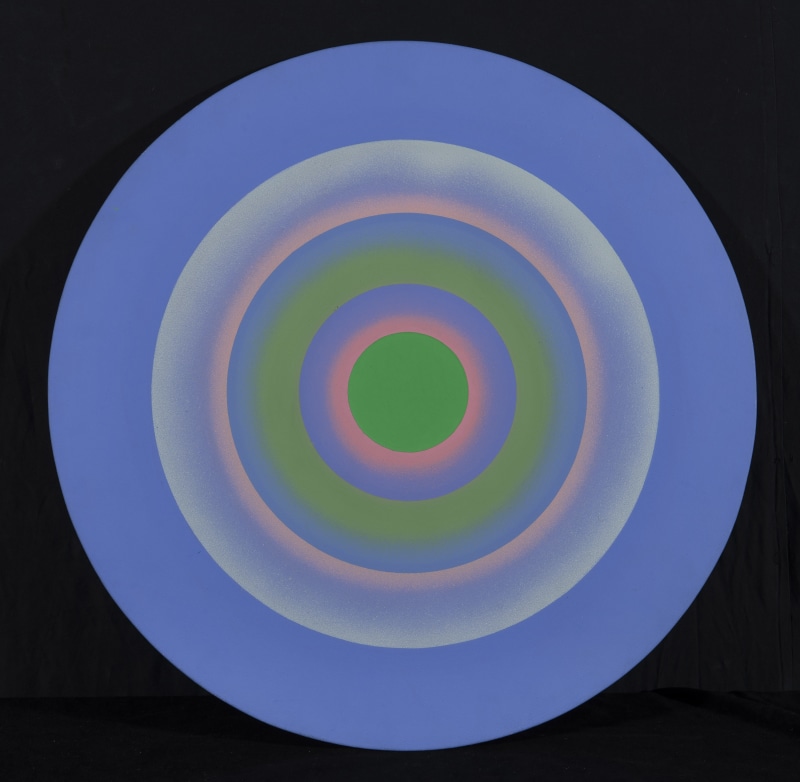 Peter SedgleyPhase 3, 1965Acrylic on canvas laid on board58.5 cm diameterSigned, dated and titled on reverse%3Cdiv%20class%3D%22artist%22%3E%3Cspan%20class%3D%22artist%22%3E%3Cstrong%3EPeter%20Sedgley%3C/strong%3E%3C/span%3E%3C/div%3E%0D%3Cdiv%20class%3D%22title%22%3E%3Cem%3EPhase%203%3C/em%3E%2C%201965%3C/div%3E%0D%3Cdiv%20class%3D%22signed_and_dated%22%3ESigned%2C%20dated%20and%20titled%20on%20reverse%3C/div%3E%0D%3Cdiv%20class%3D%22medium%22%3EAcrylic%20on%20canvas%20laid%20on%20board%3C/div%3E%0D%3Cdiv%20class%3D%22dimensions%22%3E58.5%20cm%20diameter%3C/div%3E
Peter SedgleyPhase 3, 1965Acrylic on canvas laid on board58.5 cm diameterSigned, dated and titled on reverse%3Cdiv%20class%3D%22artist%22%3E%3Cspan%20class%3D%22artist%22%3E%3Cstrong%3EPeter%20Sedgley%3C/strong%3E%3C/span%3E%3C/div%3E%0D%3Cdiv%20class%3D%22title%22%3E%3Cem%3EPhase%203%3C/em%3E%2C%201965%3C/div%3E%0D%3Cdiv%20class%3D%22signed_and_dated%22%3ESigned%2C%20dated%20and%20titled%20on%20reverse%3C/div%3E%0D%3Cdiv%20class%3D%22medium%22%3EAcrylic%20on%20canvas%20laid%20on%20board%3C/div%3E%0D%3Cdiv%20class%3D%22dimensions%22%3E58.5%20cm%20diameter%3C/div%3E -
 Peter SedgleyRed and Blue Modulation, 1964Synthetic polymer paint on masonite104 x 104 cmSigned, dated and titled on reverse%3Cdiv%20class%3D%22artist%22%3E%3Cspan%20class%3D%22artist%22%3E%3Cstrong%3EPeter%20Sedgley%3C/strong%3E%3C/span%3E%3C/div%3E%0D%3Cdiv%20class%3D%22title%22%3E%3Cem%3ERed%20and%20Blue%20Modulation%3C/em%3E%2C%201964%3C/div%3E%0D%3Cdiv%20class%3D%22signed_and_dated%22%3ESigned%2C%20dated%20and%20titled%20on%20reverse%3C/div%3E%0D%3Cdiv%20class%3D%22medium%22%3ESynthetic%20polymer%20paint%20on%20masonite%20%3C/div%3E%0D%3Cdiv%20class%3D%22dimensions%22%3E104%20x%20104%20cm%3C/div%3E
Peter SedgleyRed and Blue Modulation, 1964Synthetic polymer paint on masonite104 x 104 cmSigned, dated and titled on reverse%3Cdiv%20class%3D%22artist%22%3E%3Cspan%20class%3D%22artist%22%3E%3Cstrong%3EPeter%20Sedgley%3C/strong%3E%3C/span%3E%3C/div%3E%0D%3Cdiv%20class%3D%22title%22%3E%3Cem%3ERed%20and%20Blue%20Modulation%3C/em%3E%2C%201964%3C/div%3E%0D%3Cdiv%20class%3D%22signed_and_dated%22%3ESigned%2C%20dated%20and%20titled%20on%20reverse%3C/div%3E%0D%3Cdiv%20class%3D%22medium%22%3ESynthetic%20polymer%20paint%20on%20masonite%20%3C/div%3E%0D%3Cdiv%20class%3D%22dimensions%22%3E104%20x%20104%20cm%3C/div%3E -
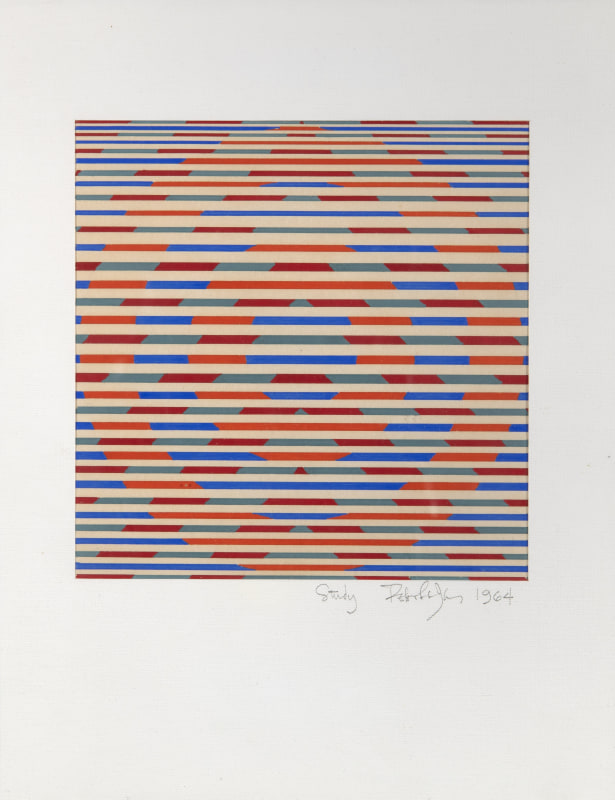 Peter SedgleyStudy, 1964Gouache on paper30.5 x 24 cm%3Cdiv%20class%3D%22artist%22%3E%3Cspan%20class%3D%22artist%22%3E%3Cstrong%3EPeter%20Sedgley%3C/strong%3E%3C/span%3E%3C/div%3E%0D%3Cdiv%20class%3D%22title%22%3E%3Cem%3EStudy%3C/em%3E%2C%201964%3C/div%3E%0D%3Cdiv%20class%3D%22medium%22%3EGouache%20on%20paper%3C/div%3E%0D%3Cdiv%20class%3D%22dimensions%22%3E30.5%20x%2024%20cm%3C/div%3E
Peter SedgleyStudy, 1964Gouache on paper30.5 x 24 cm%3Cdiv%20class%3D%22artist%22%3E%3Cspan%20class%3D%22artist%22%3E%3Cstrong%3EPeter%20Sedgley%3C/strong%3E%3C/span%3E%3C/div%3E%0D%3Cdiv%20class%3D%22title%22%3E%3Cem%3EStudy%3C/em%3E%2C%201964%3C/div%3E%0D%3Cdiv%20class%3D%22medium%22%3EGouache%20on%20paper%3C/div%3E%0D%3Cdiv%20class%3D%22dimensions%22%3E30.5%20x%2024%20cm%3C/div%3E -
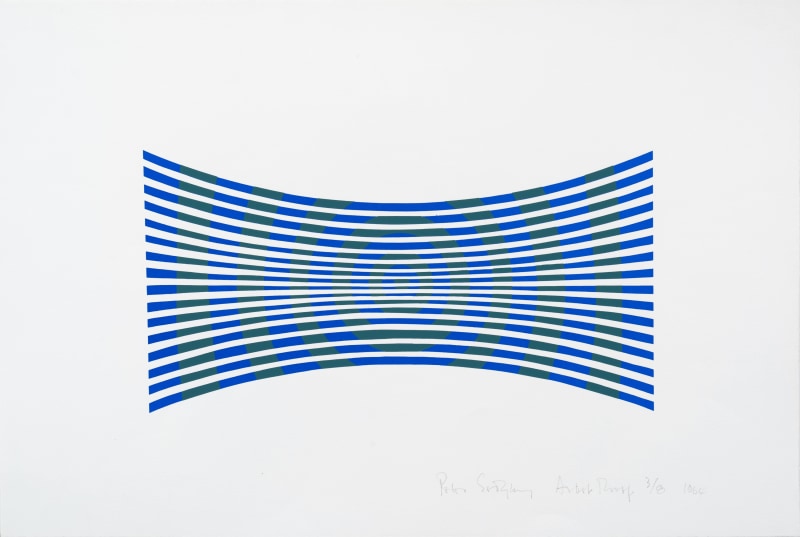 Peter SedgleyUntitled, 1964Screenprint15.5 x 30 cmFrom the edition of 8 impressionsSigned, dated and numbered%3Cdiv%20class%3D%22artist%22%3E%3Cspan%20class%3D%22artist%22%3E%3Cstrong%3EPeter%20Sedgley%3C/strong%3E%3C/span%3E%3C/div%3E%0D%3Cdiv%20class%3D%22title%22%3E%3Cem%3EUntitled%3C/em%3E%2C%201964%3C/div%3E%0D%3Cdiv%20class%3D%22signed_and_dated%22%3ESigned%2C%20dated%20and%20numbered%3C/div%3E%0D%3Cdiv%20class%3D%22medium%22%3EScreenprint%3C/div%3E%0D%3Cdiv%20class%3D%22dimensions%22%3E15.5%20x%2030%20cm%3C/div%3E%0D%3Cdiv%20class%3D%22edition_details%22%3EFrom%20the%20edition%20of%208%20impressions%3C/div%3E
Peter SedgleyUntitled, 1964Screenprint15.5 x 30 cmFrom the edition of 8 impressionsSigned, dated and numbered%3Cdiv%20class%3D%22artist%22%3E%3Cspan%20class%3D%22artist%22%3E%3Cstrong%3EPeter%20Sedgley%3C/strong%3E%3C/span%3E%3C/div%3E%0D%3Cdiv%20class%3D%22title%22%3E%3Cem%3EUntitled%3C/em%3E%2C%201964%3C/div%3E%0D%3Cdiv%20class%3D%22signed_and_dated%22%3ESigned%2C%20dated%20and%20numbered%3C/div%3E%0D%3Cdiv%20class%3D%22medium%22%3EScreenprint%3C/div%3E%0D%3Cdiv%20class%3D%22dimensions%22%3E15.5%20x%2030%20cm%3C/div%3E%0D%3Cdiv%20class%3D%22edition_details%22%3EFrom%20the%20edition%20of%208%20impressions%3C/div%3E
